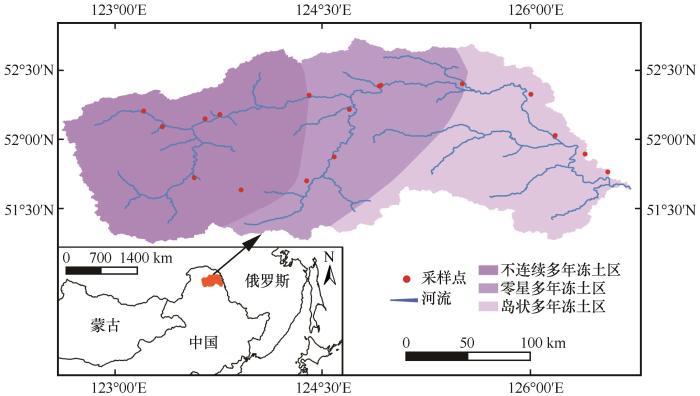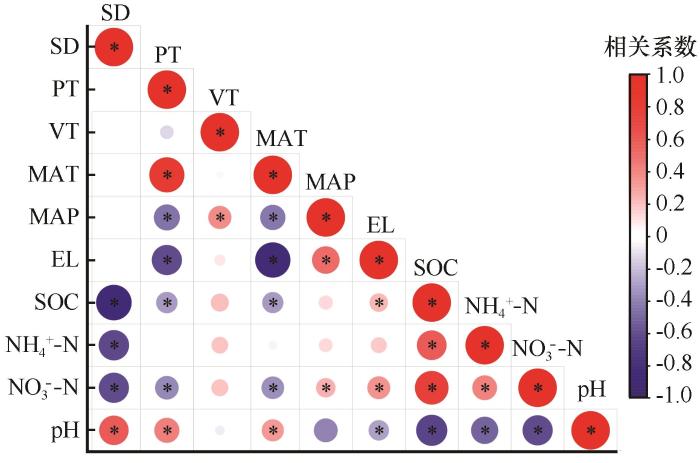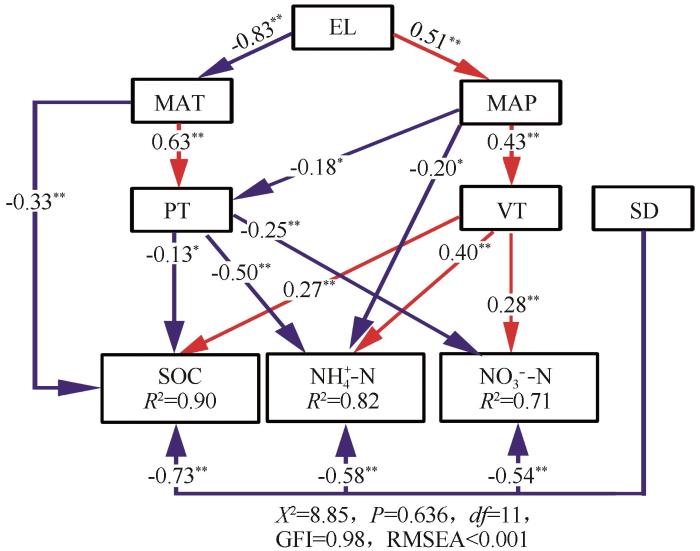Organic carbon in soils of the world
1
1993
... 土壤是陆地生态系统重要的碳库和氮库,在全球碳氮循环过程中扮演重要角色.据估计全球约有1 500 Gt碳和95 Gt氮是以有机质形态储存于土壤中[1-2],其中多年冻土区碳储量约占全球土壤碳总储量的50%以上[3].多年冻土区土壤生态系统是陆地碳汇的主体,对气候变化响应敏感,全球气候变暖显著改变了多年冻土区土壤水热动态,进而影响植被生长与有机物分解速率,最终导致土壤碳氮循环过程发生改变.明确多年冻土区土壤有机碳和有效氮含量及其影响因素,对于深入了解寒区土壤生态环境及精准评估陆地碳汇功能具有重要意义. ...
Ecological dynamics across the Arctic associated with recent climate change
1
2009
... 土壤是陆地生态系统重要的碳库和氮库,在全球碳氮循环过程中扮演重要角色.据估计全球约有1 500 Gt碳和95 Gt氮是以有机质形态储存于土壤中[1-2],其中多年冻土区碳储量约占全球土壤碳总储量的50%以上[3].多年冻土区土壤生态系统是陆地碳汇的主体,对气候变化响应敏感,全球气候变暖显著改变了多年冻土区土壤水热动态,进而影响植被生长与有机物分解速率,最终导致土壤碳氮循环过程发生改变.明确多年冻土区土壤有机碳和有效氮含量及其影响因素,对于深入了解寒区土壤生态环境及精准评估陆地碳汇功能具有重要意义. ...
Soil organic carbon pools in the northern circumpolar permafrost region
1
2009
... 土壤是陆地生态系统重要的碳库和氮库,在全球碳氮循环过程中扮演重要角色.据估计全球约有1 500 Gt碳和95 Gt氮是以有机质形态储存于土壤中[1-2],其中多年冻土区碳储量约占全球土壤碳总储量的50%以上[3].多年冻土区土壤生态系统是陆地碳汇的主体,对气候变化响应敏感,全球气候变暖显著改变了多年冻土区土壤水热动态,进而影响植被生长与有机物分解速率,最终导致土壤碳氮循环过程发生改变.明确多年冻土区土壤有机碳和有效氮含量及其影响因素,对于深入了解寒区土壤生态环境及精准评估陆地碳汇功能具有重要意义. ...
Distribution characteristics and influencing factors of soil organic carbon in Buqu catchment in the source region of the Yangtze River, China
1
2022
... 森林土壤作为陆地生态系统的主体,在全球碳循环和氮循环中发挥着不可替代的作用[4-5].自然条件下,森林土壤有机碳和有效氮分布受气候和植被等因素控制[6-8].气候通常影响土壤水热条件及植被的分布模式,植被通过自身生长及凋落物分解影响土壤碳氮含量.Xiao等[9]对大兴安岭多年冻土区不同类型落叶松森林生态系统的碳氮储量进行了研究;Wang等[10]研究了全球气候变化背景下大小兴安岭不连续多年冻土带0~40 cm土壤碳氮含量的变化特征;Groffman等[11]分析了北方多年冻土区气候变化与森林土壤碳氮循环之间的关系;Gao等[12]研究了大兴安岭多年冻土区温室气体排放的驱动因素.已有研究主要聚焦于多年冻土区浅层森林土壤碳氮储量及其变化趋势,以及全球变暖背景下温室气体排放的驱动因素.然而由于气候变暖的响应程度在不同区域间有显著差异[13],有限的野外观测和巨大的空间异质性,对于不同类型多年冻土区深层土壤有机碳和有效氮含量及空间分布模式的了解在很大程度上仍然不确定[14].因此,在全球变暖背景下需进一步明确不同类型多年冻土区深层土壤有机碳和有效氮含量及空间分布规律. ...
长江源区布曲流域土壤有机碳分布特征及其影响因素
1
2022
... 森林土壤作为陆地生态系统的主体,在全球碳循环和氮循环中发挥着不可替代的作用[4-5].自然条件下,森林土壤有机碳和有效氮分布受气候和植被等因素控制[6-8].气候通常影响土壤水热条件及植被的分布模式,植被通过自身生长及凋落物分解影响土壤碳氮含量.Xiao等[9]对大兴安岭多年冻土区不同类型落叶松森林生态系统的碳氮储量进行了研究;Wang等[10]研究了全球气候变化背景下大小兴安岭不连续多年冻土带0~40 cm土壤碳氮含量的变化特征;Groffman等[11]分析了北方多年冻土区气候变化与森林土壤碳氮循环之间的关系;Gao等[12]研究了大兴安岭多年冻土区温室气体排放的驱动因素.已有研究主要聚焦于多年冻土区浅层森林土壤碳氮储量及其变化趋势,以及全球变暖背景下温室气体排放的驱动因素.然而由于气候变暖的响应程度在不同区域间有显著差异[13],有限的野外观测和巨大的空间异质性,对于不同类型多年冻土区深层土壤有机碳和有效氮含量及空间分布模式的了解在很大程度上仍然不确定[14].因此,在全球变暖背景下需进一步明确不同类型多年冻土区深层土壤有机碳和有效氮含量及空间分布规律. ...
Characteristics of soil nitrogen mineralization in the main forest types in cold temperate zone during the spring freezing-thawing period
1
2020
... 森林土壤作为陆地生态系统的主体,在全球碳循环和氮循环中发挥着不可替代的作用[4-5].自然条件下,森林土壤有机碳和有效氮分布受气候和植被等因素控制[6-8].气候通常影响土壤水热条件及植被的分布模式,植被通过自身生长及凋落物分解影响土壤碳氮含量.Xiao等[9]对大兴安岭多年冻土区不同类型落叶松森林生态系统的碳氮储量进行了研究;Wang等[10]研究了全球气候变化背景下大小兴安岭不连续多年冻土带0~40 cm土壤碳氮含量的变化特征;Groffman等[11]分析了北方多年冻土区气候变化与森林土壤碳氮循环之间的关系;Gao等[12]研究了大兴安岭多年冻土区温室气体排放的驱动因素.已有研究主要聚焦于多年冻土区浅层森林土壤碳氮储量及其变化趋势,以及全球变暖背景下温室气体排放的驱动因素.然而由于气候变暖的响应程度在不同区域间有显著差异[13],有限的野外观测和巨大的空间异质性,对于不同类型多年冻土区深层土壤有机碳和有效氮含量及空间分布模式的了解在很大程度上仍然不确定[14].因此,在全球变暖背景下需进一步明确不同类型多年冻土区深层土壤有机碳和有效氮含量及空间分布规律. ...
春季冻融期寒温带主要森林类型土壤氮矿化特征
1
2020
... 森林土壤作为陆地生态系统的主体,在全球碳循环和氮循环中发挥着不可替代的作用[4-5].自然条件下,森林土壤有机碳和有效氮分布受气候和植被等因素控制[6-8].气候通常影响土壤水热条件及植被的分布模式,植被通过自身生长及凋落物分解影响土壤碳氮含量.Xiao等[9]对大兴安岭多年冻土区不同类型落叶松森林生态系统的碳氮储量进行了研究;Wang等[10]研究了全球气候变化背景下大小兴安岭不连续多年冻土带0~40 cm土壤碳氮含量的变化特征;Groffman等[11]分析了北方多年冻土区气候变化与森林土壤碳氮循环之间的关系;Gao等[12]研究了大兴安岭多年冻土区温室气体排放的驱动因素.已有研究主要聚焦于多年冻土区浅层森林土壤碳氮储量及其变化趋势,以及全球变暖背景下温室气体排放的驱动因素.然而由于气候变暖的响应程度在不同区域间有显著差异[13],有限的野外观测和巨大的空间异质性,对于不同类型多年冻土区深层土壤有机碳和有效氮含量及空间分布模式的了解在很大程度上仍然不确定[14].因此,在全球变暖背景下需进一步明确不同类型多年冻土区深层土壤有机碳和有效氮含量及空间分布规律. ...
Declines in northern forest tree growth following snowpack decline and soil freezing
1
2019
... 森林土壤作为陆地生态系统的主体,在全球碳循环和氮循环中发挥着不可替代的作用[4-5].自然条件下,森林土壤有机碳和有效氮分布受气候和植被等因素控制[6-8].气候通常影响土壤水热条件及植被的分布模式,植被通过自身生长及凋落物分解影响土壤碳氮含量.Xiao等[9]对大兴安岭多年冻土区不同类型落叶松森林生态系统的碳氮储量进行了研究;Wang等[10]研究了全球气候变化背景下大小兴安岭不连续多年冻土带0~40 cm土壤碳氮含量的变化特征;Groffman等[11]分析了北方多年冻土区气候变化与森林土壤碳氮循环之间的关系;Gao等[12]研究了大兴安岭多年冻土区温室气体排放的驱动因素.已有研究主要聚焦于多年冻土区浅层森林土壤碳氮储量及其变化趋势,以及全球变暖背景下温室气体排放的驱动因素.然而由于气候变暖的响应程度在不同区域间有显著差异[13],有限的野外观测和巨大的空间异质性,对于不同类型多年冻土区深层土壤有机碳和有效氮含量及空间分布模式的了解在很大程度上仍然不确定[14].因此,在全球变暖背景下需进一步明确不同类型多年冻土区深层土壤有机碳和有效氮含量及空间分布规律. ...
Growing season warming and winter freeze-thaw cycles reduce root nitrogen uptake capacity and increase soil solution nitrogen in a northern forest ecosystem
0
2018
Effects of warming, wetting and nitrogen addition on substrate-induced respiration and temperature sensitivity of heterotrophic respiration in a temperate forest soil
1
2021
... 森林土壤作为陆地生态系统的主体,在全球碳循环和氮循环中发挥着不可替代的作用[4-5].自然条件下,森林土壤有机碳和有效氮分布受气候和植被等因素控制[6-8].气候通常影响土壤水热条件及植被的分布模式,植被通过自身生长及凋落物分解影响土壤碳氮含量.Xiao等[9]对大兴安岭多年冻土区不同类型落叶松森林生态系统的碳氮储量进行了研究;Wang等[10]研究了全球气候变化背景下大小兴安岭不连续多年冻土带0~40 cm土壤碳氮含量的变化特征;Groffman等[11]分析了北方多年冻土区气候变化与森林土壤碳氮循环之间的关系;Gao等[12]研究了大兴安岭多年冻土区温室气体排放的驱动因素.已有研究主要聚焦于多年冻土区浅层森林土壤碳氮储量及其变化趋势,以及全球变暖背景下温室气体排放的驱动因素.然而由于气候变暖的响应程度在不同区域间有显著差异[13],有限的野外观测和巨大的空间异质性,对于不同类型多年冻土区深层土壤有机碳和有效氮含量及空间分布模式的了解在很大程度上仍然不确定[14].因此,在全球变暖背景下需进一步明确不同类型多年冻土区深层土壤有机碳和有效氮含量及空间分布规律. ...
Carbon and nitrogen stocks in three types of Larix gmelinii forests in Daxing’an Mountains, Northeast China
1
2020
... 森林土壤作为陆地生态系统的主体,在全球碳循环和氮循环中发挥着不可替代的作用[4-5].自然条件下,森林土壤有机碳和有效氮分布受气候和植被等因素控制[6-8].气候通常影响土壤水热条件及植被的分布模式,植被通过自身生长及凋落物分解影响土壤碳氮含量.Xiao等[9]对大兴安岭多年冻土区不同类型落叶松森林生态系统的碳氮储量进行了研究;Wang等[10]研究了全球气候变化背景下大小兴安岭不连续多年冻土带0~40 cm土壤碳氮含量的变化特征;Groffman等[11]分析了北方多年冻土区气候变化与森林土壤碳氮循环之间的关系;Gao等[12]研究了大兴安岭多年冻土区温室气体排放的驱动因素.已有研究主要聚焦于多年冻土区浅层森林土壤碳氮储量及其变化趋势,以及全球变暖背景下温室气体排放的驱动因素.然而由于气候变暖的响应程度在不同区域间有显著差异[13],有限的野外观测和巨大的空间异质性,对于不同类型多年冻土区深层土壤有机碳和有效氮含量及空间分布模式的了解在很大程度上仍然不确定[14].因此,在全球变暖背景下需进一步明确不同类型多年冻土区深层土壤有机碳和有效氮含量及空间分布规律. ...
Soil carbon and nitrogen across wetland types in discontinuous permafrost zone of the Xiao Xing’an Mountains, northeastern China
1
2013
... 森林土壤作为陆地生态系统的主体,在全球碳循环和氮循环中发挥着不可替代的作用[4-5].自然条件下,森林土壤有机碳和有效氮分布受气候和植被等因素控制[6-8].气候通常影响土壤水热条件及植被的分布模式,植被通过自身生长及凋落物分解影响土壤碳氮含量.Xiao等[9]对大兴安岭多年冻土区不同类型落叶松森林生态系统的碳氮储量进行了研究;Wang等[10]研究了全球气候变化背景下大小兴安岭不连续多年冻土带0~40 cm土壤碳氮含量的变化特征;Groffman等[11]分析了北方多年冻土区气候变化与森林土壤碳氮循环之间的关系;Gao等[12]研究了大兴安岭多年冻土区温室气体排放的驱动因素.已有研究主要聚焦于多年冻土区浅层森林土壤碳氮储量及其变化趋势,以及全球变暖背景下温室气体排放的驱动因素.然而由于气候变暖的响应程度在不同区域间有显著差异[13],有限的野外观测和巨大的空间异质性,对于不同类型多年冻土区深层土壤有机碳和有效氮含量及空间分布模式的了解在很大程度上仍然不确定[14].因此,在全球变暖背景下需进一步明确不同类型多年冻土区深层土壤有机碳和有效氮含量及空间分布规律. ...
Climate variation and soil carbon and nitrogen cycling processes in a northern hardwood forest
1
2009
... 森林土壤作为陆地生态系统的主体,在全球碳循环和氮循环中发挥着不可替代的作用[4-5].自然条件下,森林土壤有机碳和有效氮分布受气候和植被等因素控制[6-8].气候通常影响土壤水热条件及植被的分布模式,植被通过自身生长及凋落物分解影响土壤碳氮含量.Xiao等[9]对大兴安岭多年冻土区不同类型落叶松森林生态系统的碳氮储量进行了研究;Wang等[10]研究了全球气候变化背景下大小兴安岭不连续多年冻土带0~40 cm土壤碳氮含量的变化特征;Groffman等[11]分析了北方多年冻土区气候变化与森林土壤碳氮循环之间的关系;Gao等[12]研究了大兴安岭多年冻土区温室气体排放的驱动因素.已有研究主要聚焦于多年冻土区浅层森林土壤碳氮储量及其变化趋势,以及全球变暖背景下温室气体排放的驱动因素.然而由于气候变暖的响应程度在不同区域间有显著差异[13],有限的野外观测和巨大的空间异质性,对于不同类型多年冻土区深层土壤有机碳和有效氮含量及空间分布模式的了解在很大程度上仍然不确定[14].因此,在全球变暖背景下需进一步明确不同类型多年冻土区深层土壤有机碳和有效氮含量及空间分布规律. ...
Driving factors on greenhouse gas emissions in permafrost region of Daxing’an Mountains, Northeast China
1
2022
... 森林土壤作为陆地生态系统的主体,在全球碳循环和氮循环中发挥着不可替代的作用[4-5].自然条件下,森林土壤有机碳和有效氮分布受气候和植被等因素控制[6-8].气候通常影响土壤水热条件及植被的分布模式,植被通过自身生长及凋落物分解影响土壤碳氮含量.Xiao等[9]对大兴安岭多年冻土区不同类型落叶松森林生态系统的碳氮储量进行了研究;Wang等[10]研究了全球气候变化背景下大小兴安岭不连续多年冻土带0~40 cm土壤碳氮含量的变化特征;Groffman等[11]分析了北方多年冻土区气候变化与森林土壤碳氮循环之间的关系;Gao等[12]研究了大兴安岭多年冻土区温室气体排放的驱动因素.已有研究主要聚焦于多年冻土区浅层森林土壤碳氮储量及其变化趋势,以及全球变暖背景下温室气体排放的驱动因素.然而由于气候变暖的响应程度在不同区域间有显著差异[13],有限的野外观测和巨大的空间异质性,对于不同类型多年冻土区深层土壤有机碳和有效氮含量及空间分布模式的了解在很大程度上仍然不确定[14].因此,在全球变暖背景下需进一步明确不同类型多年冻土区深层土壤有机碳和有效氮含量及空间分布规律. ...
An overview on global land surface air temperature change
1
2014
... 森林土壤作为陆地生态系统的主体,在全球碳循环和氮循环中发挥着不可替代的作用[4-5].自然条件下,森林土壤有机碳和有效氮分布受气候和植被等因素控制[6-8].气候通常影响土壤水热条件及植被的分布模式,植被通过自身生长及凋落物分解影响土壤碳氮含量.Xiao等[9]对大兴安岭多年冻土区不同类型落叶松森林生态系统的碳氮储量进行了研究;Wang等[10]研究了全球气候变化背景下大小兴安岭不连续多年冻土带0~40 cm土壤碳氮含量的变化特征;Groffman等[11]分析了北方多年冻土区气候变化与森林土壤碳氮循环之间的关系;Gao等[12]研究了大兴安岭多年冻土区温室气体排放的驱动因素.已有研究主要聚焦于多年冻土区浅层森林土壤碳氮储量及其变化趋势,以及全球变暖背景下温室气体排放的驱动因素.然而由于气候变暖的响应程度在不同区域间有显著差异[13],有限的野外观测和巨大的空间异质性,对于不同类型多年冻土区深层土壤有机碳和有效氮含量及空间分布模式的了解在很大程度上仍然不确定[14].因此,在全球变暖背景下需进一步明确不同类型多年冻土区深层土壤有机碳和有效氮含量及空间分布规律. ...
全球陆地表面气温变化研究现状、问题和展望
1
2014
... 森林土壤作为陆地生态系统的主体,在全球碳循环和氮循环中发挥着不可替代的作用[4-5].自然条件下,森林土壤有机碳和有效氮分布受气候和植被等因素控制[6-8].气候通常影响土壤水热条件及植被的分布模式,植被通过自身生长及凋落物分解影响土壤碳氮含量.Xiao等[9]对大兴安岭多年冻土区不同类型落叶松森林生态系统的碳氮储量进行了研究;Wang等[10]研究了全球气候变化背景下大小兴安岭不连续多年冻土带0~40 cm土壤碳氮含量的变化特征;Groffman等[11]分析了北方多年冻土区气候变化与森林土壤碳氮循环之间的关系;Gao等[12]研究了大兴安岭多年冻土区温室气体排放的驱动因素.已有研究主要聚焦于多年冻土区浅层森林土壤碳氮储量及其变化趋势,以及全球变暖背景下温室气体排放的驱动因素.然而由于气候变暖的响应程度在不同区域间有显著差异[13],有限的野外观测和巨大的空间异质性,对于不同类型多年冻土区深层土壤有机碳和有效氮含量及空间分布模式的了解在很大程度上仍然不确定[14].因此,在全球变暖背景下需进一步明确不同类型多年冻土区深层土壤有机碳和有效氮含量及空间分布规律. ...
Soil carbon and nitrogen in the active layers of the permafrost regions in the Three Rivers’ Headstream
1
2014
... 森林土壤作为陆地生态系统的主体,在全球碳循环和氮循环中发挥着不可替代的作用[4-5].自然条件下,森林土壤有机碳和有效氮分布受气候和植被等因素控制[6-8].气候通常影响土壤水热条件及植被的分布模式,植被通过自身生长及凋落物分解影响土壤碳氮含量.Xiao等[9]对大兴安岭多年冻土区不同类型落叶松森林生态系统的碳氮储量进行了研究;Wang等[10]研究了全球气候变化背景下大小兴安岭不连续多年冻土带0~40 cm土壤碳氮含量的变化特征;Groffman等[11]分析了北方多年冻土区气候变化与森林土壤碳氮循环之间的关系;Gao等[12]研究了大兴安岭多年冻土区温室气体排放的驱动因素.已有研究主要聚焦于多年冻土区浅层森林土壤碳氮储量及其变化趋势,以及全球变暖背景下温室气体排放的驱动因素.然而由于气候变暖的响应程度在不同区域间有显著差异[13],有限的野外观测和巨大的空间异质性,对于不同类型多年冻土区深层土壤有机碳和有效氮含量及空间分布模式的了解在很大程度上仍然不确定[14].因此,在全球变暖背景下需进一步明确不同类型多年冻土区深层土壤有机碳和有效氮含量及空间分布规律. ...
Evolution of permafrost in China during the last 20 ka
1
2019
... 呼玛河流域位于大兴安岭腹地,因其独特的植被类型和气候条件,是全球气候变化响应最敏感的区域之一.过去的一个世纪里,该地区气温经历了超过1 ℃的变暖[15],冻土从连续多年冻土退化为不连续多年冻土、零星多年冻土或岛状多年冻土[16].然而,目前关于呼玛河流域不同类型冻土区土壤碳氮空间分布特征及其影响因素的研究尚缺乏,因此本文选取呼玛河流域三种类型多年冻土区(不连续多年冻土区、零星多年冻土区和岛状多年冻土区)[17],基于时空转化法[18-19],探讨多年冻土退化过程中森林土壤有机碳和有效氮含量的空间变化特征,揭示流域内森林土壤有机碳和有效氮含量的主控因素及其相对贡献.该研究有助于理解呼玛河流域不同类型多年冻土区森林土壤有机碳和有效氮分布格局及其主控因素,进而为认识高纬度多年冻土区碳氮循环及其对全球气候变化的响应和反馈作用具有重要意义. ...
Permafrost change in Northeast China in the 1950s—2010s
1
2021
... 呼玛河流域位于大兴安岭腹地,因其独特的植被类型和气候条件,是全球气候变化响应最敏感的区域之一.过去的一个世纪里,该地区气温经历了超过1 ℃的变暖[15],冻土从连续多年冻土退化为不连续多年冻土、零星多年冻土或岛状多年冻土[16].然而,目前关于呼玛河流域不同类型冻土区土壤碳氮空间分布特征及其影响因素的研究尚缺乏,因此本文选取呼玛河流域三种类型多年冻土区(不连续多年冻土区、零星多年冻土区和岛状多年冻土区)[17],基于时空转化法[18-19],探讨多年冻土退化过程中森林土壤有机碳和有效氮含量的空间变化特征,揭示流域内森林土壤有机碳和有效氮含量的主控因素及其相对贡献.该研究有助于理解呼玛河流域不同类型多年冻土区森林土壤有机碳和有效氮分布格局及其主控因素,进而为认识高纬度多年冻土区碳氮循环及其对全球气候变化的响应和反馈作用具有重要意义. ...
Circumarctic map of permafrost and ground-ice conditions: version 2
1
1993
... 呼玛河流域位于大兴安岭腹地,因其独特的植被类型和气候条件,是全球气候变化响应最敏感的区域之一.过去的一个世纪里,该地区气温经历了超过1 ℃的变暖[15],冻土从连续多年冻土退化为不连续多年冻土、零星多年冻土或岛状多年冻土[16].然而,目前关于呼玛河流域不同类型冻土区土壤碳氮空间分布特征及其影响因素的研究尚缺乏,因此本文选取呼玛河流域三种类型多年冻土区(不连续多年冻土区、零星多年冻土区和岛状多年冻土区)[17],基于时空转化法[18-19],探讨多年冻土退化过程中森林土壤有机碳和有效氮含量的空间变化特征,揭示流域内森林土壤有机碳和有效氮含量的主控因素及其相对贡献.该研究有助于理解呼玛河流域不同类型多年冻土区森林土壤有机碳和有效氮分布格局及其主控因素,进而为认识高纬度多年冻土区碳氮循环及其对全球气候变化的响应和反馈作用具有重要意义. ...
Response characteristics of vegetation and soil environment to permafrost degradation in the upstream regions of the Shule River basin
1
2012
... 呼玛河流域位于大兴安岭腹地,因其独特的植被类型和气候条件,是全球气候变化响应最敏感的区域之一.过去的一个世纪里,该地区气温经历了超过1 ℃的变暖[15],冻土从连续多年冻土退化为不连续多年冻土、零星多年冻土或岛状多年冻土[16].然而,目前关于呼玛河流域不同类型冻土区土壤碳氮空间分布特征及其影响因素的研究尚缺乏,因此本文选取呼玛河流域三种类型多年冻土区(不连续多年冻土区、零星多年冻土区和岛状多年冻土区)[17],基于时空转化法[18-19],探讨多年冻土退化过程中森林土壤有机碳和有效氮含量的空间变化特征,揭示流域内森林土壤有机碳和有效氮含量的主控因素及其相对贡献.该研究有助于理解呼玛河流域不同类型多年冻土区森林土壤有机碳和有效氮分布格局及其主控因素,进而为认识高纬度多年冻土区碳氮循环及其对全球气候变化的响应和反馈作用具有重要意义. ...
Effects of permafrost degradation on soil microbial biomass carbon and nitrogen in the Shule River headwaters, the Qilian Mountains
4
2021
... 呼玛河流域位于大兴安岭腹地,因其独特的植被类型和气候条件,是全球气候变化响应最敏感的区域之一.过去的一个世纪里,该地区气温经历了超过1 ℃的变暖[15],冻土从连续多年冻土退化为不连续多年冻土、零星多年冻土或岛状多年冻土[16].然而,目前关于呼玛河流域不同类型冻土区土壤碳氮空间分布特征及其影响因素的研究尚缺乏,因此本文选取呼玛河流域三种类型多年冻土区(不连续多年冻土区、零星多年冻土区和岛状多年冻土区)[17],基于时空转化法[18-19],探讨多年冻土退化过程中森林土壤有机碳和有效氮含量的空间变化特征,揭示流域内森林土壤有机碳和有效氮含量的主控因素及其相对贡献.该研究有助于理解呼玛河流域不同类型多年冻土区森林土壤有机碳和有效氮分布格局及其主控因素,进而为认识高纬度多年冻土区碳氮循环及其对全球气候变化的响应和反馈作用具有重要意义. ...
... 研究发现,土壤有机碳和硝态氮含量在不连续多年冻土区高于零星多年冻土区和岛状多年冻土区.Liu等[25]在大兴安岭多年冻土区土壤有机碳和有效氮的研究中指出,多年冻土区退化会影响土壤有机碳和有效氮含量.这可能是因为不同类型多年冻土区受年均气温和年降水量的影响显著,这种水热差异导致多年冻土发生退化,进而影响土壤碳氮分解程度[26].吴明辉等[19]的研究也表明,冻土退化对土壤碳氮含量的分布特征有显著的影响.而土壤铵态氮含量在零星连续多年冻土区最高,这可能是因为植被类型影响土壤铵态氮含量.根据实地调查结果显示零星多年冻土区植被类型主要以寒温带阔叶林为主,同时研究结果也显示植被类型(0.40,SEM的标准化路径系数,下同)对土壤铵态氮含量有显著的正向影响.这与鲁博权等[27]对大兴安岭典型森林土壤碳氮的研究结果相似,即多年冻土区阔叶林土壤铵态氮含量比针叶林土壤高.这是因为不同冻土区植被类型分布状况不同,导致不同地区土壤有机质含量之间产生较大的差异性,从而影响土壤铵态氮含量的分布,因此土壤铵态氮含量受植被类型影响在零星连续多年冻土区内最高.此外,由于不同类型冻土区活动层深度的不同,使得其土壤持水能力、土壤入渗能力和土壤导水率存在差异[28],导致不同类型冻土区土壤水文状况不同[29],而这些变化都可能影响植被覆盖及土壤基质分布的变化[30],进而使得土壤碳氮的空间异质性增强. ...
... 年均气温和植被类型是影响呼玛河流域土壤有机碳分布的重要因素,较低的环境温度对多年冻土区土壤有机质输入量以及土壤有机质矿化和凋落物的分解速率具有重要影响[31],而植被类型由于其生长特征和根系分泌物不同,直接或间接影响土壤微生物活性,从而使得土壤有机碳产生较大差异[32].本研究结果表明,年均气温对土壤有机碳含量有显著的负向影响,且年均气温与有机碳含量之间呈显著负相关性(P<0.05).Mishra等[33]在北半球多年冻土区土壤有机碳储量的空间异质性及环境预测的研究中指出,多年冻土区环境温度是控制有机碳含量的重要因素.因为多年冻土区环境温度会控制微生物活性及数量[34],进而对有机物的分解产生影响,从而导致温度对土壤有机碳含量产生负向影响,这也进一步解释了有机碳含量随年均气温变化的规律[22].此外,年均气温通过对不同类型多年冻土区的影响,进而间接地对土壤有机碳含量产生负向影响(图3).在全球气候变暖背景下,多年冻土区在过去的十几年中发生了不同程度的退化[19],导致了多年冻土区土壤碳的分解在增加[35],因此多年冻土区土壤有机碳含量对年均气温变化的响应十分敏感. ...
... 冻土区类型对土壤有机碳含量有显著的负向影响.程国栋等[35]在青藏高原多年冻土特征、变化及影响和吴明辉等[19]在祁连山疏勒河源区冻土退化对土壤碳氮影响的研究中指出,不同类型多年冻土区土壤有机碳含量会随冻土退化发生显著的变化.这一方面是因为研究区土壤有机质会以枯枝落叶的形式参与土壤碳库的周转过程[42],加上地表植被受到冻融收缩膨胀物理作用的影响[43],加快了枯枝落叶的粉碎化程度,使得细小物质更快地进入土壤中,从而增加土壤碳库的活性所导致的[44].另一方面可能是由于多年冻土区的冻融循环,破坏了微生物的细胞[45],促使可溶性有机物释放,从而增加土壤有机碳含量[46]. ...
祁连山疏勒河源区冻土退化对土壤微生物生物量碳氮的影响
4
2021
... 呼玛河流域位于大兴安岭腹地,因其独特的植被类型和气候条件,是全球气候变化响应最敏感的区域之一.过去的一个世纪里,该地区气温经历了超过1 ℃的变暖[15],冻土从连续多年冻土退化为不连续多年冻土、零星多年冻土或岛状多年冻土[16].然而,目前关于呼玛河流域不同类型冻土区土壤碳氮空间分布特征及其影响因素的研究尚缺乏,因此本文选取呼玛河流域三种类型多年冻土区(不连续多年冻土区、零星多年冻土区和岛状多年冻土区)[17],基于时空转化法[18-19],探讨多年冻土退化过程中森林土壤有机碳和有效氮含量的空间变化特征,揭示流域内森林土壤有机碳和有效氮含量的主控因素及其相对贡献.该研究有助于理解呼玛河流域不同类型多年冻土区森林土壤有机碳和有效氮分布格局及其主控因素,进而为认识高纬度多年冻土区碳氮循环及其对全球气候变化的响应和反馈作用具有重要意义. ...
... 研究发现,土壤有机碳和硝态氮含量在不连续多年冻土区高于零星多年冻土区和岛状多年冻土区.Liu等[25]在大兴安岭多年冻土区土壤有机碳和有效氮的研究中指出,多年冻土区退化会影响土壤有机碳和有效氮含量.这可能是因为不同类型多年冻土区受年均气温和年降水量的影响显著,这种水热差异导致多年冻土发生退化,进而影响土壤碳氮分解程度[26].吴明辉等[19]的研究也表明,冻土退化对土壤碳氮含量的分布特征有显著的影响.而土壤铵态氮含量在零星连续多年冻土区最高,这可能是因为植被类型影响土壤铵态氮含量.根据实地调查结果显示零星多年冻土区植被类型主要以寒温带阔叶林为主,同时研究结果也显示植被类型(0.40,SEM的标准化路径系数,下同)对土壤铵态氮含量有显著的正向影响.这与鲁博权等[27]对大兴安岭典型森林土壤碳氮的研究结果相似,即多年冻土区阔叶林土壤铵态氮含量比针叶林土壤高.这是因为不同冻土区植被类型分布状况不同,导致不同地区土壤有机质含量之间产生较大的差异性,从而影响土壤铵态氮含量的分布,因此土壤铵态氮含量受植被类型影响在零星连续多年冻土区内最高.此外,由于不同类型冻土区活动层深度的不同,使得其土壤持水能力、土壤入渗能力和土壤导水率存在差异[28],导致不同类型冻土区土壤水文状况不同[29],而这些变化都可能影响植被覆盖及土壤基质分布的变化[30],进而使得土壤碳氮的空间异质性增强. ...
... 年均气温和植被类型是影响呼玛河流域土壤有机碳分布的重要因素,较低的环境温度对多年冻土区土壤有机质输入量以及土壤有机质矿化和凋落物的分解速率具有重要影响[31],而植被类型由于其生长特征和根系分泌物不同,直接或间接影响土壤微生物活性,从而使得土壤有机碳产生较大差异[32].本研究结果表明,年均气温对土壤有机碳含量有显著的负向影响,且年均气温与有机碳含量之间呈显著负相关性(P<0.05).Mishra等[33]在北半球多年冻土区土壤有机碳储量的空间异质性及环境预测的研究中指出,多年冻土区环境温度是控制有机碳含量的重要因素.因为多年冻土区环境温度会控制微生物活性及数量[34],进而对有机物的分解产生影响,从而导致温度对土壤有机碳含量产生负向影响,这也进一步解释了有机碳含量随年均气温变化的规律[22].此外,年均气温通过对不同类型多年冻土区的影响,进而间接地对土壤有机碳含量产生负向影响(图3).在全球气候变暖背景下,多年冻土区在过去的十几年中发生了不同程度的退化[19],导致了多年冻土区土壤碳的分解在增加[35],因此多年冻土区土壤有机碳含量对年均气温变化的响应十分敏感. ...
... 冻土区类型对土壤有机碳含量有显著的负向影响.程国栋等[35]在青藏高原多年冻土特征、变化及影响和吴明辉等[19]在祁连山疏勒河源区冻土退化对土壤碳氮影响的研究中指出,不同类型多年冻土区土壤有机碳含量会随冻土退化发生显著的变化.这一方面是因为研究区土壤有机质会以枯枝落叶的形式参与土壤碳库的周转过程[42],加上地表植被受到冻融收缩膨胀物理作用的影响[43],加快了枯枝落叶的粉碎化程度,使得细小物质更快地进入土壤中,从而增加土壤碳库的活性所导致的[44].另一方面可能是由于多年冻土区的冻融循环,破坏了微生物的细胞[45],促使可溶性有机物释放,从而增加土壤有机碳含量[46]. ...
Relationships among soil fertility, native plant diversity and exotic plant abundance inform restoration of forb-rich eucalypt woodlands
1
2012
... 结构方程模型(SEM)使用最大似然参数估计方法,用来确定因子之间的相关关系.结构方程模型代表了一套完整的多元技术,包括测量理论、因子分析、回归、路径分析和联立方程模型等,用于描述多个潜在变量之间的多重关系[20].SEM的一个优点是,一个潜在变量在一组关系中可以是因变量,同时在另一组关系中可以是自变量.由于假设模型涉及这种多路径联系,因此SEM是适合这种分析的工具.本研究中的SEM是使用软件包AMOS 24进行的.基于科学文献中的因果关系理论,提前假设一个SEM模型,该模型包括了海拔、年均气温、年均降水量、冻土区类型、植被类型、土壤酸碱度、土壤有机碳和土壤有效氮之间所有合理的相互作用路径,并根据SEM技术进一步完善.采用了评估结构方程模型拟合的标准,如最大似然χ2值、拟合指数(GFI)和近似均方根误差(RMSEA). ...
Characteristics of soil organic carbon distribution and its controlling factors on hillslope in seasonal frozen area of Qinghai Lake basin
1
2020
... 呼玛河流域森林土壤有机碳和有效氮(铵态氮、硝态氮)含量随着土壤深度的增加逐渐降低,且差异显著(P<0.05),这与潘蕊蕊等[21]对青海湖季节冻土区土壤有机碳含量和董星丰等[22]对大兴安岭多年冻土区土壤有效氮含量随土壤深度的变化趋势基本一致.因为研究区表层土壤有机碳和有效氮含量主要是源于植被凋落物的分解和转化,且表层土壤适宜的通气状况和水热条件,为微生物活动创造了有利的环境条件,加快了土壤有机碳和有效氮的周转率,从而利于表层土壤有机碳和有效氮含量的积累[23].而深层土壤有机碳和有效氮含量较低,可能是因为深层土壤温度较低以及微生物基础呼吸强度减弱,抑制了土壤生物的生物化学过程,致使土壤有机碳和有效氮的周转率降低,从而表现为下层土壤有机碳和有效氮含量较上层的含量低[24].本文中土壤有机碳和有效氮含量之间呈显著的正相关性(P<0.05),也进一步说明了土壤有机碳和有效氮含量在深度上变化规律的相似性. ...
青海湖流域季节性冻土区坡面土壤有机碳分布特征及其影响因素
1
2020
... 呼玛河流域森林土壤有机碳和有效氮(铵态氮、硝态氮)含量随着土壤深度的增加逐渐降低,且差异显著(P<0.05),这与潘蕊蕊等[21]对青海湖季节冻土区土壤有机碳含量和董星丰等[22]对大兴安岭多年冻土区土壤有效氮含量随土壤深度的变化趋势基本一致.因为研究区表层土壤有机碳和有效氮含量主要是源于植被凋落物的分解和转化,且表层土壤适宜的通气状况和水热条件,为微生物活动创造了有利的环境条件,加快了土壤有机碳和有效氮的周转率,从而利于表层土壤有机碳和有效氮含量的积累[23].而深层土壤有机碳和有效氮含量较低,可能是因为深层土壤温度较低以及微生物基础呼吸强度减弱,抑制了土壤生物的生物化学过程,致使土壤有机碳和有效氮的周转率降低,从而表现为下层土壤有机碳和有效氮含量较上层的含量低[24].本文中土壤有机碳和有效氮含量之间呈显著的正相关性(P<0.05),也进一步说明了土壤有机碳和有效氮含量在深度上变化规律的相似性. ...
Carbon and nitrogen properties and the characteristics of soil organic carbon mineralization in permafrost regions in the northern Great Hing’an Mountains
2
2021
... 呼玛河流域森林土壤有机碳和有效氮(铵态氮、硝态氮)含量随着土壤深度的增加逐渐降低,且差异显著(P<0.05),这与潘蕊蕊等[21]对青海湖季节冻土区土壤有机碳含量和董星丰等[22]对大兴安岭多年冻土区土壤有效氮含量随土壤深度的变化趋势基本一致.因为研究区表层土壤有机碳和有效氮含量主要是源于植被凋落物的分解和转化,且表层土壤适宜的通气状况和水热条件,为微生物活动创造了有利的环境条件,加快了土壤有机碳和有效氮的周转率,从而利于表层土壤有机碳和有效氮含量的积累[23].而深层土壤有机碳和有效氮含量较低,可能是因为深层土壤温度较低以及微生物基础呼吸强度减弱,抑制了土壤生物的生物化学过程,致使土壤有机碳和有效氮的周转率降低,从而表现为下层土壤有机碳和有效氮含量较上层的含量低[24].本文中土壤有机碳和有效氮含量之间呈显著的正相关性(P<0.05),也进一步说明了土壤有机碳和有效氮含量在深度上变化规律的相似性. ...
... 年均气温和植被类型是影响呼玛河流域土壤有机碳分布的重要因素,较低的环境温度对多年冻土区土壤有机质输入量以及土壤有机质矿化和凋落物的分解速率具有重要影响[31],而植被类型由于其生长特征和根系分泌物不同,直接或间接影响土壤微生物活性,从而使得土壤有机碳产生较大差异[32].本研究结果表明,年均气温对土壤有机碳含量有显著的负向影响,且年均气温与有机碳含量之间呈显著负相关性(P<0.05).Mishra等[33]在北半球多年冻土区土壤有机碳储量的空间异质性及环境预测的研究中指出,多年冻土区环境温度是控制有机碳含量的重要因素.因为多年冻土区环境温度会控制微生物活性及数量[34],进而对有机物的分解产生影响,从而导致温度对土壤有机碳含量产生负向影响,这也进一步解释了有机碳含量随年均气温变化的规律[22].此外,年均气温通过对不同类型多年冻土区的影响,进而间接地对土壤有机碳含量产生负向影响(图3).在全球气候变暖背景下,多年冻土区在过去的十几年中发生了不同程度的退化[19],导致了多年冻土区土壤碳的分解在增加[35],因此多年冻土区土壤有机碳含量对年均气温变化的响应十分敏感. ...
大兴安岭北部多年冻土区土壤碳氮含量及有机碳矿化特征
2
2021
... 呼玛河流域森林土壤有机碳和有效氮(铵态氮、硝态氮)含量随着土壤深度的增加逐渐降低,且差异显著(P<0.05),这与潘蕊蕊等[21]对青海湖季节冻土区土壤有机碳含量和董星丰等[22]对大兴安岭多年冻土区土壤有效氮含量随土壤深度的变化趋势基本一致.因为研究区表层土壤有机碳和有效氮含量主要是源于植被凋落物的分解和转化,且表层土壤适宜的通气状况和水热条件,为微生物活动创造了有利的环境条件,加快了土壤有机碳和有效氮的周转率,从而利于表层土壤有机碳和有效氮含量的积累[23].而深层土壤有机碳和有效氮含量较低,可能是因为深层土壤温度较低以及微生物基础呼吸强度减弱,抑制了土壤生物的生物化学过程,致使土壤有机碳和有效氮的周转率降低,从而表现为下层土壤有机碳和有效氮含量较上层的含量低[24].本文中土壤有机碳和有效氮含量之间呈显著的正相关性(P<0.05),也进一步说明了土壤有机碳和有效氮含量在深度上变化规律的相似性. ...
... 年均气温和植被类型是影响呼玛河流域土壤有机碳分布的重要因素,较低的环境温度对多年冻土区土壤有机质输入量以及土壤有机质矿化和凋落物的分解速率具有重要影响[31],而植被类型由于其生长特征和根系分泌物不同,直接或间接影响土壤微生物活性,从而使得土壤有机碳产生较大差异[32].本研究结果表明,年均气温对土壤有机碳含量有显著的负向影响,且年均气温与有机碳含量之间呈显著负相关性(P<0.05).Mishra等[33]在北半球多年冻土区土壤有机碳储量的空间异质性及环境预测的研究中指出,多年冻土区环境温度是控制有机碳含量的重要因素.因为多年冻土区环境温度会控制微生物活性及数量[34],进而对有机物的分解产生影响,从而导致温度对土壤有机碳含量产生负向影响,这也进一步解释了有机碳含量随年均气温变化的规律[22].此外,年均气温通过对不同类型多年冻土区的影响,进而间接地对土壤有机碳含量产生负向影响(图3).在全球气候变暖背景下,多年冻土区在过去的十几年中发生了不同程度的退化[19],导致了多年冻土区土壤碳的分解在增加[35],因此多年冻土区土壤有机碳含量对年均气温变化的响应十分敏感. ...
The stoichiometric characteristics of soil C, N, P in mountain steppe of eastern Tibetan Plateau
1
2018
... 呼玛河流域森林土壤有机碳和有效氮(铵态氮、硝态氮)含量随着土壤深度的增加逐渐降低,且差异显著(P<0.05),这与潘蕊蕊等[21]对青海湖季节冻土区土壤有机碳含量和董星丰等[22]对大兴安岭多年冻土区土壤有效氮含量随土壤深度的变化趋势基本一致.因为研究区表层土壤有机碳和有效氮含量主要是源于植被凋落物的分解和转化,且表层土壤适宜的通气状况和水热条件,为微生物活动创造了有利的环境条件,加快了土壤有机碳和有效氮的周转率,从而利于表层土壤有机碳和有效氮含量的积累[23].而深层土壤有机碳和有效氮含量较低,可能是因为深层土壤温度较低以及微生物基础呼吸强度减弱,抑制了土壤生物的生物化学过程,致使土壤有机碳和有效氮的周转率降低,从而表现为下层土壤有机碳和有效氮含量较上层的含量低[24].本文中土壤有机碳和有效氮含量之间呈显著的正相关性(P<0.05),也进一步说明了土壤有机碳和有效氮含量在深度上变化规律的相似性. ...
青藏高原东部山地草地土壤碳、氮、磷元素计量特征
1
2018
... 呼玛河流域森林土壤有机碳和有效氮(铵态氮、硝态氮)含量随着土壤深度的增加逐渐降低,且差异显著(P<0.05),这与潘蕊蕊等[21]对青海湖季节冻土区土壤有机碳含量和董星丰等[22]对大兴安岭多年冻土区土壤有效氮含量随土壤深度的变化趋势基本一致.因为研究区表层土壤有机碳和有效氮含量主要是源于植被凋落物的分解和转化,且表层土壤适宜的通气状况和水热条件,为微生物活动创造了有利的环境条件,加快了土壤有机碳和有效氮的周转率,从而利于表层土壤有机碳和有效氮含量的积累[23].而深层土壤有机碳和有效氮含量较低,可能是因为深层土壤温度较低以及微生物基础呼吸强度减弱,抑制了土壤生物的生物化学过程,致使土壤有机碳和有效氮的周转率降低,从而表现为下层土壤有机碳和有效氮含量较上层的含量低[24].本文中土壤有机碳和有效氮含量之间呈显著的正相关性(P<0.05),也进一步说明了土壤有机碳和有效氮含量在深度上变化规律的相似性. ...
The effects of vegetation types on soil enzyme activities and soil carbon and nitrogen forms in Yanhe River basin
1
2014
... 呼玛河流域森林土壤有机碳和有效氮(铵态氮、硝态氮)含量随着土壤深度的增加逐渐降低,且差异显著(P<0.05),这与潘蕊蕊等[21]对青海湖季节冻土区土壤有机碳含量和董星丰等[22]对大兴安岭多年冻土区土壤有效氮含量随土壤深度的变化趋势基本一致.因为研究区表层土壤有机碳和有效氮含量主要是源于植被凋落物的分解和转化,且表层土壤适宜的通气状况和水热条件,为微生物活动创造了有利的环境条件,加快了土壤有机碳和有效氮的周转率,从而利于表层土壤有机碳和有效氮含量的积累[23].而深层土壤有机碳和有效氮含量较低,可能是因为深层土壤温度较低以及微生物基础呼吸强度减弱,抑制了土壤生物的生物化学过程,致使土壤有机碳和有效氮的周转率降低,从而表现为下层土壤有机碳和有效氮含量较上层的含量低[24].本文中土壤有机碳和有效氮含量之间呈显著的正相关性(P<0.05),也进一步说明了土壤有机碳和有效氮含量在深度上变化规律的相似性. ...
延河流域植被类型对土壤酶活性和土壤碳氮形态的影响
1
2014
... 呼玛河流域森林土壤有机碳和有效氮(铵态氮、硝态氮)含量随着土壤深度的增加逐渐降低,且差异显著(P<0.05),这与潘蕊蕊等[21]对青海湖季节冻土区土壤有机碳含量和董星丰等[22]对大兴安岭多年冻土区土壤有效氮含量随土壤深度的变化趋势基本一致.因为研究区表层土壤有机碳和有效氮含量主要是源于植被凋落物的分解和转化,且表层土壤适宜的通气状况和水热条件,为微生物活动创造了有利的环境条件,加快了土壤有机碳和有效氮的周转率,从而利于表层土壤有机碳和有效氮含量的积累[23].而深层土壤有机碳和有效氮含量较低,可能是因为深层土壤温度较低以及微生物基础呼吸强度减弱,抑制了土壤生物的生物化学过程,致使土壤有机碳和有效氮的周转率降低,从而表现为下层土壤有机碳和有效氮含量较上层的含量低[24].本文中土壤有机碳和有效氮含量之间呈显著的正相关性(P<0.05),也进一步说明了土壤有机碳和有效氮含量在深度上变化规律的相似性. ...
Soil enzyme activities and their relationships with soil C, N, and P in peatlands from different types of permafrost regions, Northeast China
1
2021
... 研究发现,土壤有机碳和硝态氮含量在不连续多年冻土区高于零星多年冻土区和岛状多年冻土区.Liu等[25]在大兴安岭多年冻土区土壤有机碳和有效氮的研究中指出,多年冻土区退化会影响土壤有机碳和有效氮含量.这可能是因为不同类型多年冻土区受年均气温和年降水量的影响显著,这种水热差异导致多年冻土发生退化,进而影响土壤碳氮分解程度[26].吴明辉等[19]的研究也表明,冻土退化对土壤碳氮含量的分布特征有显著的影响.而土壤铵态氮含量在零星连续多年冻土区最高,这可能是因为植被类型影响土壤铵态氮含量.根据实地调查结果显示零星多年冻土区植被类型主要以寒温带阔叶林为主,同时研究结果也显示植被类型(0.40,SEM的标准化路径系数,下同)对土壤铵态氮含量有显著的正向影响.这与鲁博权等[27]对大兴安岭典型森林土壤碳氮的研究结果相似,即多年冻土区阔叶林土壤铵态氮含量比针叶林土壤高.这是因为不同冻土区植被类型分布状况不同,导致不同地区土壤有机质含量之间产生较大的差异性,从而影响土壤铵态氮含量的分布,因此土壤铵态氮含量受植被类型影响在零星连续多年冻土区内最高.此外,由于不同类型冻土区活动层深度的不同,使得其土壤持水能力、土壤入渗能力和土壤导水率存在差异[28],导致不同类型冻土区土壤水文状况不同[29],而这些变化都可能影响植被覆盖及土壤基质分布的变化[30],进而使得土壤碳氮的空间异质性增强. ...
Permafrost existence is closely associated with soil organic matter preservation: evidence from relationships among environmental factors and soil carbon in a permafrost boundary area
1
2021
... 研究发现,土壤有机碳和硝态氮含量在不连续多年冻土区高于零星多年冻土区和岛状多年冻土区.Liu等[25]在大兴安岭多年冻土区土壤有机碳和有效氮的研究中指出,多年冻土区退化会影响土壤有机碳和有效氮含量.这可能是因为不同类型多年冻土区受年均气温和年降水量的影响显著,这种水热差异导致多年冻土发生退化,进而影响土壤碳氮分解程度[26].吴明辉等[19]的研究也表明,冻土退化对土壤碳氮含量的分布特征有显著的影响.而土壤铵态氮含量在零星连续多年冻土区最高,这可能是因为植被类型影响土壤铵态氮含量.根据实地调查结果显示零星多年冻土区植被类型主要以寒温带阔叶林为主,同时研究结果也显示植被类型(0.40,SEM的标准化路径系数,下同)对土壤铵态氮含量有显著的正向影响.这与鲁博权等[27]对大兴安岭典型森林土壤碳氮的研究结果相似,即多年冻土区阔叶林土壤铵态氮含量比针叶林土壤高.这是因为不同冻土区植被类型分布状况不同,导致不同地区土壤有机质含量之间产生较大的差异性,从而影响土壤铵态氮含量的分布,因此土壤铵态氮含量受植被类型影响在零星连续多年冻土区内最高.此外,由于不同类型冻土区活动层深度的不同,使得其土壤持水能力、土壤入渗能力和土壤导水率存在差异[28],导致不同类型冻土区土壤水文状况不同[29],而这些变化都可能影响植被覆盖及土壤基质分布的变化[30],进而使得土壤碳氮的空间异质性增强. ...
The effects of freezing-thawing process on soil active organic carbon and nitrogen mineralization in Daxing’anling Mountain forests
2
2019
... 研究发现,土壤有机碳和硝态氮含量在不连续多年冻土区高于零星多年冻土区和岛状多年冻土区.Liu等[25]在大兴安岭多年冻土区土壤有机碳和有效氮的研究中指出,多年冻土区退化会影响土壤有机碳和有效氮含量.这可能是因为不同类型多年冻土区受年均气温和年降水量的影响显著,这种水热差异导致多年冻土发生退化,进而影响土壤碳氮分解程度[26].吴明辉等[19]的研究也表明,冻土退化对土壤碳氮含量的分布特征有显著的影响.而土壤铵态氮含量在零星连续多年冻土区最高,这可能是因为植被类型影响土壤铵态氮含量.根据实地调查结果显示零星多年冻土区植被类型主要以寒温带阔叶林为主,同时研究结果也显示植被类型(0.40,SEM的标准化路径系数,下同)对土壤铵态氮含量有显著的正向影响.这与鲁博权等[27]对大兴安岭典型森林土壤碳氮的研究结果相似,即多年冻土区阔叶林土壤铵态氮含量比针叶林土壤高.这是因为不同冻土区植被类型分布状况不同,导致不同地区土壤有机质含量之间产生较大的差异性,从而影响土壤铵态氮含量的分布,因此土壤铵态氮含量受植被类型影响在零星连续多年冻土区内最高.此外,由于不同类型冻土区活动层深度的不同,使得其土壤持水能力、土壤入渗能力和土壤导水率存在差异[28],导致不同类型冻土区土壤水文状况不同[29],而这些变化都可能影响植被覆盖及土壤基质分布的变化[30],进而使得土壤碳氮的空间异质性增强. ...
... 森林土壤氮素的有效性与氮素矿化、固定、硝化和反硝化等过程密切相关.本研究结果表明植被类型对土壤有效氮含量有显著的正向影响,但不同植被分布土壤有效氮表现出明显的差异性.已有前人研究表明,寒温带阔叶林土壤铵态氮比寒温带针叶林高[27].研究区森林凋落物是土壤有效氮的重要来源,凋落物通过分解逐渐向土壤中输入养分[62],因此植被是土壤有效氮的主要来源.Duan等[63]对大兴安岭北方森林的研究也发现植物类型对土壤有效氮含量有显著的影响.此外,研究区森林生态系统中,不同植被类型土壤有效氮的差异性,可能是因为不同树种对铵态氮和硝态氮吸收速率的差异而导致[36].土壤有效氮主要以NH4+-N和NO3--N形式存在,其中NH4+-N和NO3--N是植物从土壤中吸收和利用N的主要形式[64],有利于土壤有效氮的积累,这与Elisabeth等[65]的研究一致.由此可见,植被的类型、生长和养分利用对土壤有效氮含量有着重要的作用. ...
冻融作用对大兴安岭典型森林土壤活性有机碳和氮矿化的影响
2
2019
... 研究发现,土壤有机碳和硝态氮含量在不连续多年冻土区高于零星多年冻土区和岛状多年冻土区.Liu等[25]在大兴安岭多年冻土区土壤有机碳和有效氮的研究中指出,多年冻土区退化会影响土壤有机碳和有效氮含量.这可能是因为不同类型多年冻土区受年均气温和年降水量的影响显著,这种水热差异导致多年冻土发生退化,进而影响土壤碳氮分解程度[26].吴明辉等[19]的研究也表明,冻土退化对土壤碳氮含量的分布特征有显著的影响.而土壤铵态氮含量在零星连续多年冻土区最高,这可能是因为植被类型影响土壤铵态氮含量.根据实地调查结果显示零星多年冻土区植被类型主要以寒温带阔叶林为主,同时研究结果也显示植被类型(0.40,SEM的标准化路径系数,下同)对土壤铵态氮含量有显著的正向影响.这与鲁博权等[27]对大兴安岭典型森林土壤碳氮的研究结果相似,即多年冻土区阔叶林土壤铵态氮含量比针叶林土壤高.这是因为不同冻土区植被类型分布状况不同,导致不同地区土壤有机质含量之间产生较大的差异性,从而影响土壤铵态氮含量的分布,因此土壤铵态氮含量受植被类型影响在零星连续多年冻土区内最高.此外,由于不同类型冻土区活动层深度的不同,使得其土壤持水能力、土壤入渗能力和土壤导水率存在差异[28],导致不同类型冻土区土壤水文状况不同[29],而这些变化都可能影响植被覆盖及土壤基质分布的变化[30],进而使得土壤碳氮的空间异质性增强. ...
... 森林土壤氮素的有效性与氮素矿化、固定、硝化和反硝化等过程密切相关.本研究结果表明植被类型对土壤有效氮含量有显著的正向影响,但不同植被分布土壤有效氮表现出明显的差异性.已有前人研究表明,寒温带阔叶林土壤铵态氮比寒温带针叶林高[27].研究区森林凋落物是土壤有效氮的重要来源,凋落物通过分解逐渐向土壤中输入养分[62],因此植被是土壤有效氮的主要来源.Duan等[63]对大兴安岭北方森林的研究也发现植物类型对土壤有效氮含量有显著的影响.此外,研究区森林生态系统中,不同植被类型土壤有效氮的差异性,可能是因为不同树种对铵态氮和硝态氮吸收速率的差异而导致[36].土壤有效氮主要以NH4+-N和NO3--N形式存在,其中NH4+-N和NO3--N是植物从土壤中吸收和利用N的主要形式[64],有利于土壤有效氮的积累,这与Elisabeth等[65]的研究一致.由此可见,植被的类型、生长和养分利用对土壤有效氮含量有着重要的作用. ...
The influence of freeze-thaw cycles of active soil layer on surface runoff in a permafrost watershed
1
2009
... 研究发现,土壤有机碳和硝态氮含量在不连续多年冻土区高于零星多年冻土区和岛状多年冻土区.Liu等[25]在大兴安岭多年冻土区土壤有机碳和有效氮的研究中指出,多年冻土区退化会影响土壤有机碳和有效氮含量.这可能是因为不同类型多年冻土区受年均气温和年降水量的影响显著,这种水热差异导致多年冻土发生退化,进而影响土壤碳氮分解程度[26].吴明辉等[19]的研究也表明,冻土退化对土壤碳氮含量的分布特征有显著的影响.而土壤铵态氮含量在零星连续多年冻土区最高,这可能是因为植被类型影响土壤铵态氮含量.根据实地调查结果显示零星多年冻土区植被类型主要以寒温带阔叶林为主,同时研究结果也显示植被类型(0.40,SEM的标准化路径系数,下同)对土壤铵态氮含量有显著的正向影响.这与鲁博权等[27]对大兴安岭典型森林土壤碳氮的研究结果相似,即多年冻土区阔叶林土壤铵态氮含量比针叶林土壤高.这是因为不同冻土区植被类型分布状况不同,导致不同地区土壤有机质含量之间产生较大的差异性,从而影响土壤铵态氮含量的分布,因此土壤铵态氮含量受植被类型影响在零星连续多年冻土区内最高.此外,由于不同类型冻土区活动层深度的不同,使得其土壤持水能力、土壤入渗能力和土壤导水率存在差异[28],导致不同类型冻土区土壤水文状况不同[29],而这些变化都可能影响植被覆盖及土壤基质分布的变化[30],进而使得土壤碳氮的空间异质性增强. ...
Enhanced poleward moisture transport and amplified northern high-latitude wetting trend
1
2013
... 研究发现,土壤有机碳和硝态氮含量在不连续多年冻土区高于零星多年冻土区和岛状多年冻土区.Liu等[25]在大兴安岭多年冻土区土壤有机碳和有效氮的研究中指出,多年冻土区退化会影响土壤有机碳和有效氮含量.这可能是因为不同类型多年冻土区受年均气温和年降水量的影响显著,这种水热差异导致多年冻土发生退化,进而影响土壤碳氮分解程度[26].吴明辉等[19]的研究也表明,冻土退化对土壤碳氮含量的分布特征有显著的影响.而土壤铵态氮含量在零星连续多年冻土区最高,这可能是因为植被类型影响土壤铵态氮含量.根据实地调查结果显示零星多年冻土区植被类型主要以寒温带阔叶林为主,同时研究结果也显示植被类型(0.40,SEM的标准化路径系数,下同)对土壤铵态氮含量有显著的正向影响.这与鲁博权等[27]对大兴安岭典型森林土壤碳氮的研究结果相似,即多年冻土区阔叶林土壤铵态氮含量比针叶林土壤高.这是因为不同冻土区植被类型分布状况不同,导致不同地区土壤有机质含量之间产生较大的差异性,从而影响土壤铵态氮含量的分布,因此土壤铵态氮含量受植被类型影响在零星连续多年冻土区内最高.此外,由于不同类型冻土区活动层深度的不同,使得其土壤持水能力、土壤入渗能力和土壤导水率存在差异[28],导致不同类型冻土区土壤水文状况不同[29],而这些变化都可能影响植被覆盖及土壤基质分布的变化[30],进而使得土壤碳氮的空间异质性增强. ...
Seasonal changes in runoff characteristics on a permafrost watershed in the southern mountainous region of eastern Siberia
1
2006
... 研究发现,土壤有机碳和硝态氮含量在不连续多年冻土区高于零星多年冻土区和岛状多年冻土区.Liu等[25]在大兴安岭多年冻土区土壤有机碳和有效氮的研究中指出,多年冻土区退化会影响土壤有机碳和有效氮含量.这可能是因为不同类型多年冻土区受年均气温和年降水量的影响显著,这种水热差异导致多年冻土发生退化,进而影响土壤碳氮分解程度[26].吴明辉等[19]的研究也表明,冻土退化对土壤碳氮含量的分布特征有显著的影响.而土壤铵态氮含量在零星连续多年冻土区最高,这可能是因为植被类型影响土壤铵态氮含量.根据实地调查结果显示零星多年冻土区植被类型主要以寒温带阔叶林为主,同时研究结果也显示植被类型(0.40,SEM的标准化路径系数,下同)对土壤铵态氮含量有显著的正向影响.这与鲁博权等[27]对大兴安岭典型森林土壤碳氮的研究结果相似,即多年冻土区阔叶林土壤铵态氮含量比针叶林土壤高.这是因为不同冻土区植被类型分布状况不同,导致不同地区土壤有机质含量之间产生较大的差异性,从而影响土壤铵态氮含量的分布,因此土壤铵态氮含量受植被类型影响在零星连续多年冻土区内最高.此外,由于不同类型冻土区活动层深度的不同,使得其土壤持水能力、土壤入渗能力和土壤导水率存在差异[28],导致不同类型冻土区土壤水文状况不同[29],而这些变化都可能影响植被覆盖及土壤基质分布的变化[30],进而使得土壤碳氮的空间异质性增强. ...
Variability in soil organic carbon mineralization due to different temperatures, moisture contents, and incubation periods in three Taiyue Mountain forest ecosystems
1
2019
... 年均气温和植被类型是影响呼玛河流域土壤有机碳分布的重要因素,较低的环境温度对多年冻土区土壤有机质输入量以及土壤有机质矿化和凋落物的分解速率具有重要影响[31],而植被类型由于其生长特征和根系分泌物不同,直接或间接影响土壤微生物活性,从而使得土壤有机碳产生较大差异[32].本研究结果表明,年均气温对土壤有机碳含量有显著的负向影响,且年均气温与有机碳含量之间呈显著负相关性(P<0.05).Mishra等[33]在北半球多年冻土区土壤有机碳储量的空间异质性及环境预测的研究中指出,多年冻土区环境温度是控制有机碳含量的重要因素.因为多年冻土区环境温度会控制微生物活性及数量[34],进而对有机物的分解产生影响,从而导致温度对土壤有机碳含量产生负向影响,这也进一步解释了有机碳含量随年均气温变化的规律[22].此外,年均气温通过对不同类型多年冻土区的影响,进而间接地对土壤有机碳含量产生负向影响(图3).在全球气候变暖背景下,多年冻土区在过去的十几年中发生了不同程度的退化[19],导致了多年冻土区土壤碳的分解在增加[35],因此多年冻土区土壤有机碳含量对年均气温变化的响应十分敏感. ...
太岳山森林土壤有机碳矿化随温度、湿度和培养时间的变化特征
1
2019
... 年均气温和植被类型是影响呼玛河流域土壤有机碳分布的重要因素,较低的环境温度对多年冻土区土壤有机质输入量以及土壤有机质矿化和凋落物的分解速率具有重要影响[31],而植被类型由于其生长特征和根系分泌物不同,直接或间接影响土壤微生物活性,从而使得土壤有机碳产生较大差异[32].本研究结果表明,年均气温对土壤有机碳含量有显著的负向影响,且年均气温与有机碳含量之间呈显著负相关性(P<0.05).Mishra等[33]在北半球多年冻土区土壤有机碳储量的空间异质性及环境预测的研究中指出,多年冻土区环境温度是控制有机碳含量的重要因素.因为多年冻土区环境温度会控制微生物活性及数量[34],进而对有机物的分解产生影响,从而导致温度对土壤有机碳含量产生负向影响,这也进一步解释了有机碳含量随年均气温变化的规律[22].此外,年均气温通过对不同类型多年冻土区的影响,进而间接地对土壤有机碳含量产生负向影响(图3).在全球气候变暖背景下,多年冻土区在过去的十几年中发生了不同程度的退化[19],导致了多年冻土区土壤碳的分解在增加[35],因此多年冻土区土壤有机碳含量对年均气温变化的响应十分敏感. ...
Distribution features of permafrost organic carbon density on different vegetation types in the upper reaches of Heihe River, Qilian Mountains
1
2018
... 年均气温和植被类型是影响呼玛河流域土壤有机碳分布的重要因素,较低的环境温度对多年冻土区土壤有机质输入量以及土壤有机质矿化和凋落物的分解速率具有重要影响[31],而植被类型由于其生长特征和根系分泌物不同,直接或间接影响土壤微生物活性,从而使得土壤有机碳产生较大差异[32].本研究结果表明,年均气温对土壤有机碳含量有显著的负向影响,且年均气温与有机碳含量之间呈显著负相关性(P<0.05).Mishra等[33]在北半球多年冻土区土壤有机碳储量的空间异质性及环境预测的研究中指出,多年冻土区环境温度是控制有机碳含量的重要因素.因为多年冻土区环境温度会控制微生物活性及数量[34],进而对有机物的分解产生影响,从而导致温度对土壤有机碳含量产生负向影响,这也进一步解释了有机碳含量随年均气温变化的规律[22].此外,年均气温通过对不同类型多年冻土区的影响,进而间接地对土壤有机碳含量产生负向影响(图3).在全球气候变暖背景下,多年冻土区在过去的十几年中发生了不同程度的退化[19],导致了多年冻土区土壤碳的分解在增加[35],因此多年冻土区土壤有机碳含量对年均气温变化的响应十分敏感. ...
祁连山黑河上游多年冻土区不同植被类型土壤有机碳密度分布特征
1
2018
... 年均气温和植被类型是影响呼玛河流域土壤有机碳分布的重要因素,较低的环境温度对多年冻土区土壤有机质输入量以及土壤有机质矿化和凋落物的分解速率具有重要影响[31],而植被类型由于其生长特征和根系分泌物不同,直接或间接影响土壤微生物活性,从而使得土壤有机碳产生较大差异[32].本研究结果表明,年均气温对土壤有机碳含量有显著的负向影响,且年均气温与有机碳含量之间呈显著负相关性(P<0.05).Mishra等[33]在北半球多年冻土区土壤有机碳储量的空间异质性及环境预测的研究中指出,多年冻土区环境温度是控制有机碳含量的重要因素.因为多年冻土区环境温度会控制微生物活性及数量[34],进而对有机物的分解产生影响,从而导致温度对土壤有机碳含量产生负向影响,这也进一步解释了有机碳含量随年均气温变化的规律[22].此外,年均气温通过对不同类型多年冻土区的影响,进而间接地对土壤有机碳含量产生负向影响(图3).在全球气候变暖背景下,多年冻土区在过去的十几年中发生了不同程度的退化[19],导致了多年冻土区土壤碳的分解在增加[35],因此多年冻土区土壤有机碳含量对年均气温变化的响应十分敏感. ...
Spatial heterogeneity and environmental predictors of permafrost region soil organic carbon stocks
1
2021
... 年均气温和植被类型是影响呼玛河流域土壤有机碳分布的重要因素,较低的环境温度对多年冻土区土壤有机质输入量以及土壤有机质矿化和凋落物的分解速率具有重要影响[31],而植被类型由于其生长特征和根系分泌物不同,直接或间接影响土壤微生物活性,从而使得土壤有机碳产生较大差异[32].本研究结果表明,年均气温对土壤有机碳含量有显著的负向影响,且年均气温与有机碳含量之间呈显著负相关性(P<0.05).Mishra等[33]在北半球多年冻土区土壤有机碳储量的空间异质性及环境预测的研究中指出,多年冻土区环境温度是控制有机碳含量的重要因素.因为多年冻土区环境温度会控制微生物活性及数量[34],进而对有机物的分解产生影响,从而导致温度对土壤有机碳含量产生负向影响,这也进一步解释了有机碳含量随年均气温变化的规律[22].此外,年均气温通过对不同类型多年冻土区的影响,进而间接地对土壤有机碳含量产生负向影响(图3).在全球气候变暖背景下,多年冻土区在过去的十几年中发生了不同程度的退化[19],导致了多年冻土区土壤碳的分解在增加[35],因此多年冻土区土壤有机碳含量对年均气温变化的响应十分敏感. ...
Progress of studies on permafrost microbial ecology in the past 10 years
1
2012
... 年均气温和植被类型是影响呼玛河流域土壤有机碳分布的重要因素,较低的环境温度对多年冻土区土壤有机质输入量以及土壤有机质矿化和凋落物的分解速率具有重要影响[31],而植被类型由于其生长特征和根系分泌物不同,直接或间接影响土壤微生物活性,从而使得土壤有机碳产生较大差异[32].本研究结果表明,年均气温对土壤有机碳含量有显著的负向影响,且年均气温与有机碳含量之间呈显著负相关性(P<0.05).Mishra等[33]在北半球多年冻土区土壤有机碳储量的空间异质性及环境预测的研究中指出,多年冻土区环境温度是控制有机碳含量的重要因素.因为多年冻土区环境温度会控制微生物活性及数量[34],进而对有机物的分解产生影响,从而导致温度对土壤有机碳含量产生负向影响,这也进一步解释了有机碳含量随年均气温变化的规律[22].此外,年均气温通过对不同类型多年冻土区的影响,进而间接地对土壤有机碳含量产生负向影响(图3).在全球气候变暖背景下,多年冻土区在过去的十几年中发生了不同程度的退化[19],导致了多年冻土区土壤碳的分解在增加[35],因此多年冻土区土壤有机碳含量对年均气温变化的响应十分敏感. ...
近10 a来冻土微生物生态学研究进展
1
2012
... 年均气温和植被类型是影响呼玛河流域土壤有机碳分布的重要因素,较低的环境温度对多年冻土区土壤有机质输入量以及土壤有机质矿化和凋落物的分解速率具有重要影响[31],而植被类型由于其生长特征和根系分泌物不同,直接或间接影响土壤微生物活性,从而使得土壤有机碳产生较大差异[32].本研究结果表明,年均气温对土壤有机碳含量有显著的负向影响,且年均气温与有机碳含量之间呈显著负相关性(P<0.05).Mishra等[33]在北半球多年冻土区土壤有机碳储量的空间异质性及环境预测的研究中指出,多年冻土区环境温度是控制有机碳含量的重要因素.因为多年冻土区环境温度会控制微生物活性及数量[34],进而对有机物的分解产生影响,从而导致温度对土壤有机碳含量产生负向影响,这也进一步解释了有机碳含量随年均气温变化的规律[22].此外,年均气温通过对不同类型多年冻土区的影响,进而间接地对土壤有机碳含量产生负向影响(图3).在全球气候变暖背景下,多年冻土区在过去的十几年中发生了不同程度的退化[19],导致了多年冻土区土壤碳的分解在增加[35],因此多年冻土区土壤有机碳含量对年均气温变化的响应十分敏感. ...
Characteristic, changes and impacts of permafrost on Qinghai-Tibet Plateau
2
2019
... 年均气温和植被类型是影响呼玛河流域土壤有机碳分布的重要因素,较低的环境温度对多年冻土区土壤有机质输入量以及土壤有机质矿化和凋落物的分解速率具有重要影响[31],而植被类型由于其生长特征和根系分泌物不同,直接或间接影响土壤微生物活性,从而使得土壤有机碳产生较大差异[32].本研究结果表明,年均气温对土壤有机碳含量有显著的负向影响,且年均气温与有机碳含量之间呈显著负相关性(P<0.05).Mishra等[33]在北半球多年冻土区土壤有机碳储量的空间异质性及环境预测的研究中指出,多年冻土区环境温度是控制有机碳含量的重要因素.因为多年冻土区环境温度会控制微生物活性及数量[34],进而对有机物的分解产生影响,从而导致温度对土壤有机碳含量产生负向影响,这也进一步解释了有机碳含量随年均气温变化的规律[22].此外,年均气温通过对不同类型多年冻土区的影响,进而间接地对土壤有机碳含量产生负向影响(图3).在全球气候变暖背景下,多年冻土区在过去的十几年中发生了不同程度的退化[19],导致了多年冻土区土壤碳的分解在增加[35],因此多年冻土区土壤有机碳含量对年均气温变化的响应十分敏感. ...
... 冻土区类型对土壤有机碳含量有显著的负向影响.程国栋等[35]在青藏高原多年冻土特征、变化及影响和吴明辉等[19]在祁连山疏勒河源区冻土退化对土壤碳氮影响的研究中指出,不同类型多年冻土区土壤有机碳含量会随冻土退化发生显著的变化.这一方面是因为研究区土壤有机质会以枯枝落叶的形式参与土壤碳库的周转过程[42],加上地表植被受到冻融收缩膨胀物理作用的影响[43],加快了枯枝落叶的粉碎化程度,使得细小物质更快地进入土壤中,从而增加土壤碳库的活性所导致的[44].另一方面可能是由于多年冻土区的冻融循环,破坏了微生物的细胞[45],促使可溶性有机物释放,从而增加土壤有机碳含量[46]. ...
青藏高原多年冻土特征、变化及影响
2
2019
... 年均气温和植被类型是影响呼玛河流域土壤有机碳分布的重要因素,较低的环境温度对多年冻土区土壤有机质输入量以及土壤有机质矿化和凋落物的分解速率具有重要影响[31],而植被类型由于其生长特征和根系分泌物不同,直接或间接影响土壤微生物活性,从而使得土壤有机碳产生较大差异[32].本研究结果表明,年均气温对土壤有机碳含量有显著的负向影响,且年均气温与有机碳含量之间呈显著负相关性(P<0.05).Mishra等[33]在北半球多年冻土区土壤有机碳储量的空间异质性及环境预测的研究中指出,多年冻土区环境温度是控制有机碳含量的重要因素.因为多年冻土区环境温度会控制微生物活性及数量[34],进而对有机物的分解产生影响,从而导致温度对土壤有机碳含量产生负向影响,这也进一步解释了有机碳含量随年均气温变化的规律[22].此外,年均气温通过对不同类型多年冻土区的影响,进而间接地对土壤有机碳含量产生负向影响(图3).在全球气候变暖背景下,多年冻土区在过去的十几年中发生了不同程度的退化[19],导致了多年冻土区土壤碳的分解在增加[35],因此多年冻土区土壤有机碳含量对年均气温变化的响应十分敏感. ...
... 冻土区类型对土壤有机碳含量有显著的负向影响.程国栋等[35]在青藏高原多年冻土特征、变化及影响和吴明辉等[19]在祁连山疏勒河源区冻土退化对土壤碳氮影响的研究中指出,不同类型多年冻土区土壤有机碳含量会随冻土退化发生显著的变化.这一方面是因为研究区土壤有机质会以枯枝落叶的形式参与土壤碳库的周转过程[42],加上地表植被受到冻融收缩膨胀物理作用的影响[43],加快了枯枝落叶的粉碎化程度,使得细小物质更快地进入土壤中,从而增加土壤碳库的活性所导致的[44].另一方面可能是由于多年冻土区的冻融循环,破坏了微生物的细胞[45],促使可溶性有机物释放,从而增加土壤有机碳含量[46]. ...
Litter decomposition and nutrient release of typical forest communities in non-growing season in cold temperate zone
2
2022
... 植被类型对土壤有机碳含量有显著的正向影响,其中寒温带针叶林土壤有机碳含量高于寒温带混交林和寒温带阔叶林.已有研究表明,我国东北寒温带地区针叶林土壤有机碳含量最高[36].呼玛河流域森林资源丰富,土壤枯枝落叶和根系分泌物较多,促进了植物凋落物转化为土壤有机质,从而有利于提高土壤有机碳含量的积累[37].王園博等[38]在黑河中游对不同植物群落土壤有机碳的研究中也发现,不同植物群落土壤有机碳存在显著差异,且植物群落(0.22)对土壤有机碳含量有显著的正向影响,但其相关系数低于本研究结果的值(0.27).这主要是因为本研究区森林植被生长比黑河中游茂盛,同时凋落物和土壤有机质分解缓慢,有利于土壤有机碳的积累.此外,森林根系的分布状态会直接影响到土壤有机碳含量,由于森林根系的密度会随着土壤深度的增加而逐渐降低,导致深层土壤植物的根系相对较少,进而表现为土壤有机碳含量随土壤深度呈减少的趋势[39].同时随着土壤深度的增加,深层土壤环境变得相对封闭[40],有机质的输入量以及微生物的活动减弱,导致有机碳的主要源为植物的深层根系[41].因此,研究区0~20、20~40 cm土层的有机碳含量显著高于40~100 cm的三个土层(P<0.05),这与植被根系数量和土壤剖面中分布形态密切相关. ...
... 森林土壤氮素的有效性与氮素矿化、固定、硝化和反硝化等过程密切相关.本研究结果表明植被类型对土壤有效氮含量有显著的正向影响,但不同植被分布土壤有效氮表现出明显的差异性.已有前人研究表明,寒温带阔叶林土壤铵态氮比寒温带针叶林高[27].研究区森林凋落物是土壤有效氮的重要来源,凋落物通过分解逐渐向土壤中输入养分[62],因此植被是土壤有效氮的主要来源.Duan等[63]对大兴安岭北方森林的研究也发现植物类型对土壤有效氮含量有显著的影响.此外,研究区森林生态系统中,不同植被类型土壤有效氮的差异性,可能是因为不同树种对铵态氮和硝态氮吸收速率的差异而导致[36].土壤有效氮主要以NH4+-N和NO3--N形式存在,其中NH4+-N和NO3--N是植物从土壤中吸收和利用N的主要形式[64],有利于土壤有效氮的积累,这与Elisabeth等[65]的研究一致.由此可见,植被的类型、生长和养分利用对土壤有效氮含量有着重要的作用. ...
寒温带地区非生长季典型森林群落凋落物分解及养分释放
2
2022
... 植被类型对土壤有机碳含量有显著的正向影响,其中寒温带针叶林土壤有机碳含量高于寒温带混交林和寒温带阔叶林.已有研究表明,我国东北寒温带地区针叶林土壤有机碳含量最高[36].呼玛河流域森林资源丰富,土壤枯枝落叶和根系分泌物较多,促进了植物凋落物转化为土壤有机质,从而有利于提高土壤有机碳含量的积累[37].王園博等[38]在黑河中游对不同植物群落土壤有机碳的研究中也发现,不同植物群落土壤有机碳存在显著差异,且植物群落(0.22)对土壤有机碳含量有显著的正向影响,但其相关系数低于本研究结果的值(0.27).这主要是因为本研究区森林植被生长比黑河中游茂盛,同时凋落物和土壤有机质分解缓慢,有利于土壤有机碳的积累.此外,森林根系的分布状态会直接影响到土壤有机碳含量,由于森林根系的密度会随着土壤深度的增加而逐渐降低,导致深层土壤植物的根系相对较少,进而表现为土壤有机碳含量随土壤深度呈减少的趋势[39].同时随着土壤深度的增加,深层土壤环境变得相对封闭[40],有机质的输入量以及微生物的活动减弱,导致有机碳的主要源为植物的深层根系[41].因此,研究区0~20、20~40 cm土层的有机碳含量显著高于40~100 cm的三个土层(P<0.05),这与植被根系数量和土壤剖面中分布形态密切相关. ...
... 森林土壤氮素的有效性与氮素矿化、固定、硝化和反硝化等过程密切相关.本研究结果表明植被类型对土壤有效氮含量有显著的正向影响,但不同植被分布土壤有效氮表现出明显的差异性.已有前人研究表明,寒温带阔叶林土壤铵态氮比寒温带针叶林高[27].研究区森林凋落物是土壤有效氮的重要来源,凋落物通过分解逐渐向土壤中输入养分[62],因此植被是土壤有效氮的主要来源.Duan等[63]对大兴安岭北方森林的研究也发现植物类型对土壤有效氮含量有显著的影响.此外,研究区森林生态系统中,不同植被类型土壤有效氮的差异性,可能是因为不同树种对铵态氮和硝态氮吸收速率的差异而导致[36].土壤有效氮主要以NH4+-N和NO3--N形式存在,其中NH4+-N和NO3--N是植物从土壤中吸收和利用N的主要形式[64],有利于土壤有效氮的积累,这与Elisabeth等[65]的研究一致.由此可见,植被的类型、生长和养分利用对土壤有效氮含量有着重要的作用. ...
Organic carbon and nitrogen characteristics of soil aggregates in four forest types in frigid temperate zone
1
2021
... 植被类型对土壤有机碳含量有显著的正向影响,其中寒温带针叶林土壤有机碳含量高于寒温带混交林和寒温带阔叶林.已有研究表明,我国东北寒温带地区针叶林土壤有机碳含量最高[36].呼玛河流域森林资源丰富,土壤枯枝落叶和根系分泌物较多,促进了植物凋落物转化为土壤有机质,从而有利于提高土壤有机碳含量的积累[37].王園博等[38]在黑河中游对不同植物群落土壤有机碳的研究中也发现,不同植物群落土壤有机碳存在显著差异,且植物群落(0.22)对土壤有机碳含量有显著的正向影响,但其相关系数低于本研究结果的值(0.27).这主要是因为本研究区森林植被生长比黑河中游茂盛,同时凋落物和土壤有机质分解缓慢,有利于土壤有机碳的积累.此外,森林根系的分布状态会直接影响到土壤有机碳含量,由于森林根系的密度会随着土壤深度的增加而逐渐降低,导致深层土壤植物的根系相对较少,进而表现为土壤有机碳含量随土壤深度呈减少的趋势[39].同时随着土壤深度的增加,深层土壤环境变得相对封闭[40],有机质的输入量以及微生物的活动减弱,导致有机碳的主要源为植物的深层根系[41].因此,研究区0~20、20~40 cm土层的有机碳含量显著高于40~100 cm的三个土层(P<0.05),这与植被根系数量和土壤剖面中分布形态密切相关. ...
寒温带4种森林类型土壤团聚体有机碳氮特征
1
2021
... 植被类型对土壤有机碳含量有显著的正向影响,其中寒温带针叶林土壤有机碳含量高于寒温带混交林和寒温带阔叶林.已有研究表明,我国东北寒温带地区针叶林土壤有机碳含量最高[36].呼玛河流域森林资源丰富,土壤枯枝落叶和根系分泌物较多,促进了植物凋落物转化为土壤有机质,从而有利于提高土壤有机碳含量的积累[37].王園博等[38]在黑河中游对不同植物群落土壤有机碳的研究中也发现,不同植物群落土壤有机碳存在显著差异,且植物群落(0.22)对土壤有机碳含量有显著的正向影响,但其相关系数低于本研究结果的值(0.27).这主要是因为本研究区森林植被生长比黑河中游茂盛,同时凋落物和土壤有机质分解缓慢,有利于土壤有机碳的积累.此外,森林根系的分布状态会直接影响到土壤有机碳含量,由于森林根系的密度会随着土壤深度的增加而逐渐降低,导致深层土壤植物的根系相对较少,进而表现为土壤有机碳含量随土壤深度呈减少的趋势[39].同时随着土壤深度的增加,深层土壤环境变得相对封闭[40],有机质的输入量以及微生物的活动减弱,导致有机碳的主要源为植物的深层根系[41].因此,研究区0~20、20~40 cm土层的有机碳含量显著高于40~100 cm的三个土层(P<0.05),这与植被根系数量和土壤剖面中分布形态密切相关. ...
Soil organic carbon and its influencing factors on the different plant communities in the middle reaches of the Heihe River wetland
1
2020
... 植被类型对土壤有机碳含量有显著的正向影响,其中寒温带针叶林土壤有机碳含量高于寒温带混交林和寒温带阔叶林.已有研究表明,我国东北寒温带地区针叶林土壤有机碳含量最高[36].呼玛河流域森林资源丰富,土壤枯枝落叶和根系分泌物较多,促进了植物凋落物转化为土壤有机质,从而有利于提高土壤有机碳含量的积累[37].王園博等[38]在黑河中游对不同植物群落土壤有机碳的研究中也发现,不同植物群落土壤有机碳存在显著差异,且植物群落(0.22)对土壤有机碳含量有显著的正向影响,但其相关系数低于本研究结果的值(0.27).这主要是因为本研究区森林植被生长比黑河中游茂盛,同时凋落物和土壤有机质分解缓慢,有利于土壤有机碳的积累.此外,森林根系的分布状态会直接影响到土壤有机碳含量,由于森林根系的密度会随着土壤深度的增加而逐渐降低,导致深层土壤植物的根系相对较少,进而表现为土壤有机碳含量随土壤深度呈减少的趋势[39].同时随着土壤深度的增加,深层土壤环境变得相对封闭[40],有机质的输入量以及微生物的活动减弱,导致有机碳的主要源为植物的深层根系[41].因此,研究区0~20、20~40 cm土层的有机碳含量显著高于40~100 cm的三个土层(P<0.05),这与植被根系数量和土壤剖面中分布形态密切相关. ...
黑河中游湿地不同植物群落土壤有机碳分布及影响因素
1
2020
... 植被类型对土壤有机碳含量有显著的正向影响,其中寒温带针叶林土壤有机碳含量高于寒温带混交林和寒温带阔叶林.已有研究表明,我国东北寒温带地区针叶林土壤有机碳含量最高[36].呼玛河流域森林资源丰富,土壤枯枝落叶和根系分泌物较多,促进了植物凋落物转化为土壤有机质,从而有利于提高土壤有机碳含量的积累[37].王園博等[38]在黑河中游对不同植物群落土壤有机碳的研究中也发现,不同植物群落土壤有机碳存在显著差异,且植物群落(0.22)对土壤有机碳含量有显著的正向影响,但其相关系数低于本研究结果的值(0.27).这主要是因为本研究区森林植被生长比黑河中游茂盛,同时凋落物和土壤有机质分解缓慢,有利于土壤有机碳的积累.此外,森林根系的分布状态会直接影响到土壤有机碳含量,由于森林根系的密度会随着土壤深度的增加而逐渐降低,导致深层土壤植物的根系相对较少,进而表现为土壤有机碳含量随土壤深度呈减少的趋势[39].同时随着土壤深度的增加,深层土壤环境变得相对封闭[40],有机质的输入量以及微生物的活动减弱,导致有机碳的主要源为植物的深层根系[41].因此,研究区0~20、20~40 cm土层的有机碳含量显著高于40~100 cm的三个土层(P<0.05),这与植被根系数量和土壤剖面中分布形态密切相关. ...
A review of research on soil carbon storage and its influencing factors in the Tibetan Plateau
1
2019
... 植被类型对土壤有机碳含量有显著的正向影响,其中寒温带针叶林土壤有机碳含量高于寒温带混交林和寒温带阔叶林.已有研究表明,我国东北寒温带地区针叶林土壤有机碳含量最高[36].呼玛河流域森林资源丰富,土壤枯枝落叶和根系分泌物较多,促进了植物凋落物转化为土壤有机质,从而有利于提高土壤有机碳含量的积累[37].王園博等[38]在黑河中游对不同植物群落土壤有机碳的研究中也发现,不同植物群落土壤有机碳存在显著差异,且植物群落(0.22)对土壤有机碳含量有显著的正向影响,但其相关系数低于本研究结果的值(0.27).这主要是因为本研究区森林植被生长比黑河中游茂盛,同时凋落物和土壤有机质分解缓慢,有利于土壤有机碳的积累.此外,森林根系的分布状态会直接影响到土壤有机碳含量,由于森林根系的密度会随着土壤深度的增加而逐渐降低,导致深层土壤植物的根系相对较少,进而表现为土壤有机碳含量随土壤深度呈减少的趋势[39].同时随着土壤深度的增加,深层土壤环境变得相对封闭[40],有机质的输入量以及微生物的活动减弱,导致有机碳的主要源为植物的深层根系[41].因此,研究区0~20、20~40 cm土层的有机碳含量显著高于40~100 cm的三个土层(P<0.05),这与植被根系数量和土壤剖面中分布形态密切相关. ...
青藏高原土壤碳储量及其影响因素研究进展
1
2019
... 植被类型对土壤有机碳含量有显著的正向影响,其中寒温带针叶林土壤有机碳含量高于寒温带混交林和寒温带阔叶林.已有研究表明,我国东北寒温带地区针叶林土壤有机碳含量最高[36].呼玛河流域森林资源丰富,土壤枯枝落叶和根系分泌物较多,促进了植物凋落物转化为土壤有机质,从而有利于提高土壤有机碳含量的积累[37].王園博等[38]在黑河中游对不同植物群落土壤有机碳的研究中也发现,不同植物群落土壤有机碳存在显著差异,且植物群落(0.22)对土壤有机碳含量有显著的正向影响,但其相关系数低于本研究结果的值(0.27).这主要是因为本研究区森林植被生长比黑河中游茂盛,同时凋落物和土壤有机质分解缓慢,有利于土壤有机碳的积累.此外,森林根系的分布状态会直接影响到土壤有机碳含量,由于森林根系的密度会随着土壤深度的增加而逐渐降低,导致深层土壤植物的根系相对较少,进而表现为土壤有机碳含量随土壤深度呈减少的趋势[39].同时随着土壤深度的增加,深层土壤环境变得相对封闭[40],有机质的输入量以及微生物的活动减弱,导致有机碳的主要源为植物的深层根系[41].因此,研究区0~20、20~40 cm土层的有机碳含量显著高于40~100 cm的三个土层(P<0.05),这与植被根系数量和土壤剖面中分布形态密切相关. ...
Vertical distribution of soil organic carbon content and its influencing factors in Aaohan, Chifeng
1
2019
... 植被类型对土壤有机碳含量有显著的正向影响,其中寒温带针叶林土壤有机碳含量高于寒温带混交林和寒温带阔叶林.已有研究表明,我国东北寒温带地区针叶林土壤有机碳含量最高[36].呼玛河流域森林资源丰富,土壤枯枝落叶和根系分泌物较多,促进了植物凋落物转化为土壤有机质,从而有利于提高土壤有机碳含量的积累[37].王園博等[38]在黑河中游对不同植物群落土壤有机碳的研究中也发现,不同植物群落土壤有机碳存在显著差异,且植物群落(0.22)对土壤有机碳含量有显著的正向影响,但其相关系数低于本研究结果的值(0.27).这主要是因为本研究区森林植被生长比黑河中游茂盛,同时凋落物和土壤有机质分解缓慢,有利于土壤有机碳的积累.此外,森林根系的分布状态会直接影响到土壤有机碳含量,由于森林根系的密度会随着土壤深度的增加而逐渐降低,导致深层土壤植物的根系相对较少,进而表现为土壤有机碳含量随土壤深度呈减少的趋势[39].同时随着土壤深度的增加,深层土壤环境变得相对封闭[40],有机质的输入量以及微生物的活动减弱,导致有机碳的主要源为植物的深层根系[41].因此,研究区0~20、20~40 cm土层的有机碳含量显著高于40~100 cm的三个土层(P<0.05),这与植被根系数量和土壤剖面中分布形态密切相关. ...
赤峰市敖汉旗土壤有机碳含量的垂直分布及其影响因素
1
2019
... 植被类型对土壤有机碳含量有显著的正向影响,其中寒温带针叶林土壤有机碳含量高于寒温带混交林和寒温带阔叶林.已有研究表明,我国东北寒温带地区针叶林土壤有机碳含量最高[36].呼玛河流域森林资源丰富,土壤枯枝落叶和根系分泌物较多,促进了植物凋落物转化为土壤有机质,从而有利于提高土壤有机碳含量的积累[37].王園博等[38]在黑河中游对不同植物群落土壤有机碳的研究中也发现,不同植物群落土壤有机碳存在显著差异,且植物群落(0.22)对土壤有机碳含量有显著的正向影响,但其相关系数低于本研究结果的值(0.27).这主要是因为本研究区森林植被生长比黑河中游茂盛,同时凋落物和土壤有机质分解缓慢,有利于土壤有机碳的积累.此外,森林根系的分布状态会直接影响到土壤有机碳含量,由于森林根系的密度会随着土壤深度的增加而逐渐降低,导致深层土壤植物的根系相对较少,进而表现为土壤有机碳含量随土壤深度呈减少的趋势[39].同时随着土壤深度的增加,深层土壤环境变得相对封闭[40],有机质的输入量以及微生物的活动减弱,导致有机碳的主要源为植物的深层根系[41].因此,研究区0~20、20~40 cm土层的有机碳含量显著高于40~100 cm的三个土层(P<0.05),这与植被根系数量和土壤剖面中分布形态密切相关. ...
Distribution characteristics of soil organic carbon and its influencing factors in different vegetation types in loess region of northern Shaanxi Province, northwestern China
1
2020
... 植被类型对土壤有机碳含量有显著的正向影响,其中寒温带针叶林土壤有机碳含量高于寒温带混交林和寒温带阔叶林.已有研究表明,我国东北寒温带地区针叶林土壤有机碳含量最高[36].呼玛河流域森林资源丰富,土壤枯枝落叶和根系分泌物较多,促进了植物凋落物转化为土壤有机质,从而有利于提高土壤有机碳含量的积累[37].王園博等[38]在黑河中游对不同植物群落土壤有机碳的研究中也发现,不同植物群落土壤有机碳存在显著差异,且植物群落(0.22)对土壤有机碳含量有显著的正向影响,但其相关系数低于本研究结果的值(0.27).这主要是因为本研究区森林植被生长比黑河中游茂盛,同时凋落物和土壤有机质分解缓慢,有利于土壤有机碳的积累.此外,森林根系的分布状态会直接影响到土壤有机碳含量,由于森林根系的密度会随着土壤深度的增加而逐渐降低,导致深层土壤植物的根系相对较少,进而表现为土壤有机碳含量随土壤深度呈减少的趋势[39].同时随着土壤深度的增加,深层土壤环境变得相对封闭[40],有机质的输入量以及微生物的活动减弱,导致有机碳的主要源为植物的深层根系[41].因此,研究区0~20、20~40 cm土层的有机碳含量显著高于40~100 cm的三个土层(P<0.05),这与植被根系数量和土壤剖面中分布形态密切相关. ...
陕北黄土区不同植被类型土壤有机碳分布特征及其影响因素
1
2020
... 植被类型对土壤有机碳含量有显著的正向影响,其中寒温带针叶林土壤有机碳含量高于寒温带混交林和寒温带阔叶林.已有研究表明,我国东北寒温带地区针叶林土壤有机碳含量最高[36].呼玛河流域森林资源丰富,土壤枯枝落叶和根系分泌物较多,促进了植物凋落物转化为土壤有机质,从而有利于提高土壤有机碳含量的积累[37].王園博等[38]在黑河中游对不同植物群落土壤有机碳的研究中也发现,不同植物群落土壤有机碳存在显著差异,且植物群落(0.22)对土壤有机碳含量有显著的正向影响,但其相关系数低于本研究结果的值(0.27).这主要是因为本研究区森林植被生长比黑河中游茂盛,同时凋落物和土壤有机质分解缓慢,有利于土壤有机碳的积累.此外,森林根系的分布状态会直接影响到土壤有机碳含量,由于森林根系的密度会随着土壤深度的增加而逐渐降低,导致深层土壤植物的根系相对较少,进而表现为土壤有机碳含量随土壤深度呈减少的趋势[39].同时随着土壤深度的增加,深层土壤环境变得相对封闭[40],有机质的输入量以及微生物的活动减弱,导致有机碳的主要源为植物的深层根系[41].因此,研究区0~20、20~40 cm土层的有机碳含量显著高于40~100 cm的三个土层(P<0.05),这与植被根系数量和土壤剖面中分布形态密切相关. ...
Change characteristics and influencing factors of soil organic carbon in Castanopsis eyrei natural forests at different altitudes in Wuyishan Nature Reserve
1
2021
... 冻土区类型对土壤有机碳含量有显著的负向影响.程国栋等[35]在青藏高原多年冻土特征、变化及影响和吴明辉等[19]在祁连山疏勒河源区冻土退化对土壤碳氮影响的研究中指出,不同类型多年冻土区土壤有机碳含量会随冻土退化发生显著的变化.这一方面是因为研究区土壤有机质会以枯枝落叶的形式参与土壤碳库的周转过程[42],加上地表植被受到冻融收缩膨胀物理作用的影响[43],加快了枯枝落叶的粉碎化程度,使得细小物质更快地进入土壤中,从而增加土壤碳库的活性所导致的[44].另一方面可能是由于多年冻土区的冻融循环,破坏了微生物的细胞[45],促使可溶性有机物释放,从而增加土壤有机碳含量[46]. ...
武夷山自然保护区不同海拔甜槠天然林土壤有机碳变化特征及影响因素
1
2021
... 冻土区类型对土壤有机碳含量有显著的负向影响.程国栋等[35]在青藏高原多年冻土特征、变化及影响和吴明辉等[19]在祁连山疏勒河源区冻土退化对土壤碳氮影响的研究中指出,不同类型多年冻土区土壤有机碳含量会随冻土退化发生显著的变化.这一方面是因为研究区土壤有机质会以枯枝落叶的形式参与土壤碳库的周转过程[42],加上地表植被受到冻融收缩膨胀物理作用的影响[43],加快了枯枝落叶的粉碎化程度,使得细小物质更快地进入土壤中,从而增加土壤碳库的活性所导致的[44].另一方面可能是由于多年冻土区的冻融循环,破坏了微生物的细胞[45],促使可溶性有机物释放,从而增加土壤有机碳含量[46]. ...
Vegetation can strongly regulate permafrost degradation at its southern edge through changing surface freeze-thaw processes
1
2018
... 冻土区类型对土壤有机碳含量有显著的负向影响.程国栋等[35]在青藏高原多年冻土特征、变化及影响和吴明辉等[19]在祁连山疏勒河源区冻土退化对土壤碳氮影响的研究中指出,不同类型多年冻土区土壤有机碳含量会随冻土退化发生显著的变化.这一方面是因为研究区土壤有机质会以枯枝落叶的形式参与土壤碳库的周转过程[42],加上地表植被受到冻融收缩膨胀物理作用的影响[43],加快了枯枝落叶的粉碎化程度,使得细小物质更快地进入土壤中,从而增加土壤碳库的活性所导致的[44].另一方面可能是由于多年冻土区的冻融循环,破坏了微生物的细胞[45],促使可溶性有机物释放,从而增加土壤有机碳含量[46]. ...
Progress in the study of effect of freeze-thaw processes on the organic carbon pool and microorganisms in soils
1
2011
... 冻土区类型对土壤有机碳含量有显著的负向影响.程国栋等[35]在青藏高原多年冻土特征、变化及影响和吴明辉等[19]在祁连山疏勒河源区冻土退化对土壤碳氮影响的研究中指出,不同类型多年冻土区土壤有机碳含量会随冻土退化发生显著的变化.这一方面是因为研究区土壤有机质会以枯枝落叶的形式参与土壤碳库的周转过程[42],加上地表植被受到冻融收缩膨胀物理作用的影响[43],加快了枯枝落叶的粉碎化程度,使得细小物质更快地进入土壤中,从而增加土壤碳库的活性所导致的[44].另一方面可能是由于多年冻土区的冻融循环,破坏了微生物的细胞[45],促使可溶性有机物释放,从而增加土壤有机碳含量[46]. ...
冻融作用对土壤有机碳库及微生物的影响研究进展
1
2011
... 冻土区类型对土壤有机碳含量有显著的负向影响.程国栋等[35]在青藏高原多年冻土特征、变化及影响和吴明辉等[19]在祁连山疏勒河源区冻土退化对土壤碳氮影响的研究中指出,不同类型多年冻土区土壤有机碳含量会随冻土退化发生显著的变化.这一方面是因为研究区土壤有机质会以枯枝落叶的形式参与土壤碳库的周转过程[42],加上地表植被受到冻融收缩膨胀物理作用的影响[43],加快了枯枝落叶的粉碎化程度,使得细小物质更快地进入土壤中,从而增加土壤碳库的活性所导致的[44].另一方面可能是由于多年冻土区的冻融循环,破坏了微生物的细胞[45],促使可溶性有机物释放,从而增加土壤有机碳含量[46]. ...
Effects of freezing-thawing cycles on soil organic carbon mineralization in the peatland ecosystems from continuous permafrost zone, Great Hinggan Mountains
1
2018
... 冻土区类型对土壤有机碳含量有显著的负向影响.程国栋等[35]在青藏高原多年冻土特征、变化及影响和吴明辉等[19]在祁连山疏勒河源区冻土退化对土壤碳氮影响的研究中指出,不同类型多年冻土区土壤有机碳含量会随冻土退化发生显著的变化.这一方面是因为研究区土壤有机质会以枯枝落叶的形式参与土壤碳库的周转过程[42],加上地表植被受到冻融收缩膨胀物理作用的影响[43],加快了枯枝落叶的粉碎化程度,使得细小物质更快地进入土壤中,从而增加土壤碳库的活性所导致的[44].另一方面可能是由于多年冻土区的冻融循环,破坏了微生物的细胞[45],促使可溶性有机物释放,从而增加土壤有机碳含量[46]. ...
冻融作用对大兴安岭多年冻土区泥炭地土壤有机碳矿化的影响研究
1
2018
... 冻土区类型对土壤有机碳含量有显著的负向影响.程国栋等[35]在青藏高原多年冻土特征、变化及影响和吴明辉等[19]在祁连山疏勒河源区冻土退化对土壤碳氮影响的研究中指出,不同类型多年冻土区土壤有机碳含量会随冻土退化发生显著的变化.这一方面是因为研究区土壤有机质会以枯枝落叶的形式参与土壤碳库的周转过程[42],加上地表植被受到冻融收缩膨胀物理作用的影响[43],加快了枯枝落叶的粉碎化程度,使得细小物质更快地进入土壤中,从而增加土壤碳库的活性所导致的[44].另一方面可能是由于多年冻土区的冻融循环,破坏了微生物的细胞[45],促使可溶性有机物释放,从而增加土壤有机碳含量[46]. ...
Microbial response to freeze-thaw cycles in tundra and taiga soils
1
1996
... 冻土区类型对土壤有机碳含量有显著的负向影响.程国栋等[35]在青藏高原多年冻土特征、变化及影响和吴明辉等[19]在祁连山疏勒河源区冻土退化对土壤碳氮影响的研究中指出,不同类型多年冻土区土壤有机碳含量会随冻土退化发生显著的变化.这一方面是因为研究区土壤有机质会以枯枝落叶的形式参与土壤碳库的周转过程[42],加上地表植被受到冻融收缩膨胀物理作用的影响[43],加快了枯枝落叶的粉碎化程度,使得细小物质更快地进入土壤中,从而增加土壤碳库的活性所导致的[44].另一方面可能是由于多年冻土区的冻融循环,破坏了微生物的细胞[45],促使可溶性有机物释放,从而增加土壤有机碳含量[46]. ...
Factor contribution to soil organic and inorganic carbon accumulation in the Loess Plateau: structural equation modeling
1
2019
... 年均降水量对土壤有机碳含量的负向影响不显著,这与Zhao等[47]在黄土高原土壤有机碳和无机碳积累研究结果不同,这种差异可能是由于研究区域的差异所导致.本研究区采样点距离呼玛河较近,降水对多年冻土区土壤水分的补给可能低于河流的补给;另外随着土壤深度增加,雨水的入渗过程和通气状况逐渐减弱[48],导致降水对土壤有机碳含量的影响不显著.丁亚鹏等[49]的研究也指出,地表堆积的大量枯枝落叶,会对降水产生缓冲截留的作用.此外,在气候变暖背景下,多年冻土区地下冰的融化也会释放一定的水分,参与到土壤水循环[50].因此土壤有机碳含量对年均降水量的响应程度较弱. ...
Effects of revegetation and precipitation gradient on soil carbon and nitrogen variations in deep profiles on the Loess Plateau of China
1
2018
... 年均降水量对土壤有机碳含量的负向影响不显著,这与Zhao等[47]在黄土高原土壤有机碳和无机碳积累研究结果不同,这种差异可能是由于研究区域的差异所导致.本研究区采样点距离呼玛河较近,降水对多年冻土区土壤水分的补给可能低于河流的补给;另外随着土壤深度增加,雨水的入渗过程和通气状况逐渐减弱[48],导致降水对土壤有机碳含量的影响不显著.丁亚鹏等[49]的研究也指出,地表堆积的大量枯枝落叶,会对降水产生缓冲截留的作用.此外,在气候变暖背景下,多年冻土区地下冰的融化也会释放一定的水分,参与到土壤水循环[50].因此土壤有机碳含量对年均降水量的响应程度较弱. ...
Spatial distribution characteristics and influencing factors of soil organic carbon in Yihe River Basin based on GWR model
1
2021
... 年均降水量对土壤有机碳含量的负向影响不显著,这与Zhao等[47]在黄土高原土壤有机碳和无机碳积累研究结果不同,这种差异可能是由于研究区域的差异所导致.本研究区采样点距离呼玛河较近,降水对多年冻土区土壤水分的补给可能低于河流的补给;另外随着土壤深度增加,雨水的入渗过程和通气状况逐渐减弱[48],导致降水对土壤有机碳含量的影响不显著.丁亚鹏等[49]的研究也指出,地表堆积的大量枯枝落叶,会对降水产生缓冲截留的作用.此外,在气候变暖背景下,多年冻土区地下冰的融化也会释放一定的水分,参与到土壤水循环[50].因此土壤有机碳含量对年均降水量的响应程度较弱. ...
基于GWR模型的伊河流域土壤有机碳空间分布特征及影响因素分析
1
2021
... 年均降水量对土壤有机碳含量的负向影响不显著,这与Zhao等[47]在黄土高原土壤有机碳和无机碳积累研究结果不同,这种差异可能是由于研究区域的差异所导致.本研究区采样点距离呼玛河较近,降水对多年冻土区土壤水分的补给可能低于河流的补给;另外随着土壤深度增加,雨水的入渗过程和通气状况逐渐减弱[48],导致降水对土壤有机碳含量的影响不显著.丁亚鹏等[49]的研究也指出,地表堆积的大量枯枝落叶,会对降水产生缓冲截留的作用.此外,在气候变暖背景下,多年冻土区地下冰的融化也会释放一定的水分,参与到土壤水循环[50].因此土壤有机碳含量对年均降水量的响应程度较弱. ...
Stability of permafrost slopes: a review
1
2022
... 年均降水量对土壤有机碳含量的负向影响不显著,这与Zhao等[47]在黄土高原土壤有机碳和无机碳积累研究结果不同,这种差异可能是由于研究区域的差异所导致.本研究区采样点距离呼玛河较近,降水对多年冻土区土壤水分的补给可能低于河流的补给;另外随着土壤深度增加,雨水的入渗过程和通气状况逐渐减弱[48],导致降水对土壤有机碳含量的影响不显著.丁亚鹏等[49]的研究也指出,地表堆积的大量枯枝落叶,会对降水产生缓冲截留的作用.此外,在气候变暖背景下,多年冻土区地下冰的融化也会释放一定的水分,参与到土壤水循环[50].因此土壤有机碳含量对年均降水量的响应程度较弱. ...
多年冻土区斜坡稳定性研究综述
1
2022
... 年均降水量对土壤有机碳含量的负向影响不显著,这与Zhao等[47]在黄土高原土壤有机碳和无机碳积累研究结果不同,这种差异可能是由于研究区域的差异所导致.本研究区采样点距离呼玛河较近,降水对多年冻土区土壤水分的补给可能低于河流的补给;另外随着土壤深度增加,雨水的入渗过程和通气状况逐渐减弱[48],导致降水对土壤有机碳含量的影响不显著.丁亚鹏等[49]的研究也指出,地表堆积的大量枯枝落叶,会对降水产生缓冲截留的作用.此外,在气候变暖背景下,多年冻土区地下冰的融化也会释放一定的水分,参与到土壤水循环[50].因此土壤有机碳含量对年均降水量的响应程度较弱. ...
The nitrogen cascade
1
2003
... 土壤有效氮积累受土壤水分、温度、植被、冻土等各种因素的影响[51].本研究结果显示,年均气温对土壤有效氮含量的影响不显著(图3).这是由于研究区年均气温常年低于0 ℃,可能引起土壤微生物种群之间对温度的耐受力产生差异,而土壤微生物是影响土壤有效氮含量的关键因素[52],从而使有效氮含量变得相对复杂.此外,年均气温通过对多年冻土区的影响,间接地影响土壤有机质和植物可利用的养分含量[53],而土壤有机质和植物可利用的养分含量又与土壤有效氮含量具有密切的联系.谭波等[54]对川西亚高山-高山森林土壤养分的研究中指出土壤有机质会促进冻土区土壤铵态氮和硝态氮含量.因此研究结果显示土壤有效氮受年均气温的直接影响不显著. ...
Seasonal variation characteristics of soil microbial community structure in Zhalong wetland
1
2018
... 土壤有效氮积累受土壤水分、温度、植被、冻土等各种因素的影响[51].本研究结果显示,年均气温对土壤有效氮含量的影响不显著(图3).这是由于研究区年均气温常年低于0 ℃,可能引起土壤微生物种群之间对温度的耐受力产生差异,而土壤微生物是影响土壤有效氮含量的关键因素[52],从而使有效氮含量变得相对复杂.此外,年均气温通过对多年冻土区的影响,间接地影响土壤有机质和植物可利用的养分含量[53],而土壤有机质和植物可利用的养分含量又与土壤有效氮含量具有密切的联系.谭波等[54]对川西亚高山-高山森林土壤养分的研究中指出土壤有机质会促进冻土区土壤铵态氮和硝态氮含量.因此研究结果显示土壤有效氮受年均气温的直接影响不显著. ...
扎龙湿地土壤微生物群落结构的季节变化特征
1
2018
... 土壤有效氮积累受土壤水分、温度、植被、冻土等各种因素的影响[51].本研究结果显示,年均气温对土壤有效氮含量的影响不显著(图3).这是由于研究区年均气温常年低于0 ℃,可能引起土壤微生物种群之间对温度的耐受力产生差异,而土壤微生物是影响土壤有效氮含量的关键因素[52],从而使有效氮含量变得相对复杂.此外,年均气温通过对多年冻土区的影响,间接地影响土壤有机质和植物可利用的养分含量[53],而土壤有机质和植物可利用的养分含量又与土壤有效氮含量具有密切的联系.谭波等[54]对川西亚高山-高山森林土壤养分的研究中指出土壤有机质会促进冻土区土壤铵态氮和硝态氮含量.因此研究结果显示土壤有效氮受年均气温的直接影响不显著. ...
Responses of root functional traits to experimental warming in the alpine meadow with different soil moisture in the permafrost region of the Qinghai-Tibet Plateau
1
2020
... 土壤有效氮积累受土壤水分、温度、植被、冻土等各种因素的影响[51].本研究结果显示,年均气温对土壤有效氮含量的影响不显著(图3).这是由于研究区年均气温常年低于0 ℃,可能引起土壤微生物种群之间对温度的耐受力产生差异,而土壤微生物是影响土壤有效氮含量的关键因素[52],从而使有效氮含量变得相对复杂.此外,年均气温通过对多年冻土区的影响,间接地影响土壤有机质和植物可利用的养分含量[53],而土壤有机质和植物可利用的养分含量又与土壤有效氮含量具有密切的联系.谭波等[54]对川西亚高山-高山森林土壤养分的研究中指出土壤有机质会促进冻土区土壤铵态氮和硝态氮含量.因此研究结果显示土壤有效氮受年均气温的直接影响不显著. ...
青藏高原多年冻土区不同水分条件的高寒草甸根系功能性状对增温的响应
1
2020
... 土壤有效氮积累受土壤水分、温度、植被、冻土等各种因素的影响[51].本研究结果显示,年均气温对土壤有效氮含量的影响不显著(图3).这是由于研究区年均气温常年低于0 ℃,可能引起土壤微生物种群之间对温度的耐受力产生差异,而土壤微生物是影响土壤有效氮含量的关键因素[52],从而使有效氮含量变得相对复杂.此外,年均气温通过对多年冻土区的影响,间接地影响土壤有机质和植物可利用的养分含量[53],而土壤有机质和植物可利用的养分含量又与土壤有效氮含量具有密切的联系.谭波等[54]对川西亚高山-高山森林土壤养分的研究中指出土壤有机质会促进冻土区土壤铵态氮和硝态氮含量.因此研究结果显示土壤有效氮受年均气温的直接影响不显著. ...
Dynamics of soil nutrients and their response to seasonal freeze-thaw in the subalpine-alpine forests of western Sichuan
1
2015
... 土壤有效氮积累受土壤水分、温度、植被、冻土等各种因素的影响[51].本研究结果显示,年均气温对土壤有效氮含量的影响不显著(图3).这是由于研究区年均气温常年低于0 ℃,可能引起土壤微生物种群之间对温度的耐受力产生差异,而土壤微生物是影响土壤有效氮含量的关键因素[52],从而使有效氮含量变得相对复杂.此外,年均气温通过对多年冻土区的影响,间接地影响土壤有机质和植物可利用的养分含量[53],而土壤有机质和植物可利用的养分含量又与土壤有效氮含量具有密切的联系.谭波等[54]对川西亚高山-高山森林土壤养分的研究中指出土壤有机质会促进冻土区土壤铵态氮和硝态氮含量.因此研究结果显示土壤有效氮受年均气温的直接影响不显著. ...
川西亚高山-高山森林土壤养分动态及其对季节性冻融的响应
1
2015
... 土壤有效氮积累受土壤水分、温度、植被、冻土等各种因素的影响[51].本研究结果显示,年均气温对土壤有效氮含量的影响不显著(图3).这是由于研究区年均气温常年低于0 ℃,可能引起土壤微生物种群之间对温度的耐受力产生差异,而土壤微生物是影响土壤有效氮含量的关键因素[52],从而使有效氮含量变得相对复杂.此外,年均气温通过对多年冻土区的影响,间接地影响土壤有机质和植物可利用的养分含量[53],而土壤有机质和植物可利用的养分含量又与土壤有效氮含量具有密切的联系.谭波等[54]对川西亚高山-高山森林土壤养分的研究中指出土壤有机质会促进冻土区土壤铵态氮和硝态氮含量.因此研究结果显示土壤有效氮受年均气温的直接影响不显著. ...
Effects of temperature and moisture changes on functional gene abundance of soil nitrogen cycle in permafrost peatland
2
2021
... 冻土区类型对土壤铵态氮和硝态氮的负向影响程度不尽相同,这是由于冻土区生态环境稳定性对环境温度的变化十分敏感[55],年均气温上升会加速多年冻土的退化,进而改变土壤中氮的矿化速率[56].此外,研究区冻土区活动层常年处于冷湿状态,在厌氧条件下增强反硝化作用,不利于硝态氮的积累;同时多年冻土区的冻融作用提高了土壤中亚硝酸和硝酸还原酶的活性,进而促进了硝酸离子还原,导致土壤中硝态氮含量降低[57].因此,冻土区类型对土壤硝态氮呈现出负向影响.土壤铵态氮受冻土区类型影响更为强烈.这可能是冻土冻融过程中土壤粒径发生了变化,引起了土壤孔隙度的变化,从而增强了土壤对氮素的固持能力[58].已有学者也证实了土壤粒径是控制土壤铵态氮吸附的重要因素,尤其是对深层土壤[59].同时冻融作用会导致部分微生物死亡,在土壤融化期间死亡微生物会成为存活微生物的基质,从而提高存活的微生物活性,促进土壤冻融过程中矿化氮的增加,而矿化氮中主要成分是铵态氮[60].因此,冻土区类型对土壤铵态氮(-0.50)的影响要强于硝态氮(-0.25). ...
... 年均降水量对土壤有效氮的影响存在差异,对土壤铵态氮为显著的负向影响,对土壤硝态氮的影响不显著,这与马秀艳等[55]的研究结果不同.造成上述差异的原因可能有以下几点:第一,野外环境与室内模拟实验相比较,野外环境变得更加复杂,不可控因素较多,造成了有效氮与年均降水量关系的差异性;第二,采样点位于多年冻土区河流较近的地方,加上土壤冻结期冻土的保水性[61],使得土壤水分不受限制,在这种条件下微生物的活性增强了氨化作用抑制了硝化作用;第三,由于硝态氮携带土壤胶体排斥的负电荷,而铵态氮携带的正电荷对土壤具有吸附作用,在降雨的同时会有淋溶作用将硝态氮带入深层土壤并进入地下水流失.这些原因的综合影响造成了年均降水量对土壤有效氮的差异性.因此土壤铵态氮受年均降水量的影响显著. ...
温度和水分变化对冻土区泥炭地土壤氮循环功能基因丰度的影响
2
2021
... 冻土区类型对土壤铵态氮和硝态氮的负向影响程度不尽相同,这是由于冻土区生态环境稳定性对环境温度的变化十分敏感[55],年均气温上升会加速多年冻土的退化,进而改变土壤中氮的矿化速率[56].此外,研究区冻土区活动层常年处于冷湿状态,在厌氧条件下增强反硝化作用,不利于硝态氮的积累;同时多年冻土区的冻融作用提高了土壤中亚硝酸和硝酸还原酶的活性,进而促进了硝酸离子还原,导致土壤中硝态氮含量降低[57].因此,冻土区类型对土壤硝态氮呈现出负向影响.土壤铵态氮受冻土区类型影响更为强烈.这可能是冻土冻融过程中土壤粒径发生了变化,引起了土壤孔隙度的变化,从而增强了土壤对氮素的固持能力[58].已有学者也证实了土壤粒径是控制土壤铵态氮吸附的重要因素,尤其是对深层土壤[59].同时冻融作用会导致部分微生物死亡,在土壤融化期间死亡微生物会成为存活微生物的基质,从而提高存活的微生物活性,促进土壤冻融过程中矿化氮的增加,而矿化氮中主要成分是铵态氮[60].因此,冻土区类型对土壤铵态氮(-0.50)的影响要强于硝态氮(-0.25). ...
... 年均降水量对土壤有效氮的影响存在差异,对土壤铵态氮为显著的负向影响,对土壤硝态氮的影响不显著,这与马秀艳等[55]的研究结果不同.造成上述差异的原因可能有以下几点:第一,野外环境与室内模拟实验相比较,野外环境变得更加复杂,不可控因素较多,造成了有效氮与年均降水量关系的差异性;第二,采样点位于多年冻土区河流较近的地方,加上土壤冻结期冻土的保水性[61],使得土壤水分不受限制,在这种条件下微生物的活性增强了氨化作用抑制了硝化作用;第三,由于硝态氮携带土壤胶体排斥的负电荷,而铵态氮携带的正电荷对土壤具有吸附作用,在降雨的同时会有淋溶作用将硝态氮带入深层土壤并进入地下水流失.这些原因的综合影响造成了年均降水量对土壤有效氮的差异性.因此土壤铵态氮受年均降水量的影响显著. ...
Responses of soil inorganic nitrogen to warming and altered precipitation in an alpine meadow on the Qinghai-Tibetan Plateau
1
2016
... 冻土区类型对土壤铵态氮和硝态氮的负向影响程度不尽相同,这是由于冻土区生态环境稳定性对环境温度的变化十分敏感[55],年均气温上升会加速多年冻土的退化,进而改变土壤中氮的矿化速率[56].此外,研究区冻土区活动层常年处于冷湿状态,在厌氧条件下增强反硝化作用,不利于硝态氮的积累;同时多年冻土区的冻融作用提高了土壤中亚硝酸和硝酸还原酶的活性,进而促进了硝酸离子还原,导致土壤中硝态氮含量降低[57].因此,冻土区类型对土壤硝态氮呈现出负向影响.土壤铵态氮受冻土区类型影响更为强烈.这可能是冻土冻融过程中土壤粒径发生了变化,引起了土壤孔隙度的变化,从而增强了土壤对氮素的固持能力[58].已有学者也证实了土壤粒径是控制土壤铵态氮吸附的重要因素,尤其是对深层土壤[59].同时冻融作用会导致部分微生物死亡,在土壤融化期间死亡微生物会成为存活微生物的基质,从而提高存活的微生物活性,促进土壤冻融过程中矿化氮的增加,而矿化氮中主要成分是铵态氮[60].因此,冻土区类型对土壤铵态氮(-0.50)的影响要强于硝态氮(-0.25). ...
青藏高原高寒草甸土壤无机氮对增温和降水改变的响应
1
2016
... 冻土区类型对土壤铵态氮和硝态氮的负向影响程度不尽相同,这是由于冻土区生态环境稳定性对环境温度的变化十分敏感[55],年均气温上升会加速多年冻土的退化,进而改变土壤中氮的矿化速率[56].此外,研究区冻土区活动层常年处于冷湿状态,在厌氧条件下增强反硝化作用,不利于硝态氮的积累;同时多年冻土区的冻融作用提高了土壤中亚硝酸和硝酸还原酶的活性,进而促进了硝酸离子还原,导致土壤中硝态氮含量降低[57].因此,冻土区类型对土壤硝态氮呈现出负向影响.土壤铵态氮受冻土区类型影响更为强烈.这可能是冻土冻融过程中土壤粒径发生了变化,引起了土壤孔隙度的变化,从而增强了土壤对氮素的固持能力[58].已有学者也证实了土壤粒径是控制土壤铵态氮吸附的重要因素,尤其是对深层土壤[59].同时冻融作用会导致部分微生物死亡,在土壤融化期间死亡微生物会成为存活微生物的基质,从而提高存活的微生物活性,促进土壤冻融过程中矿化氮的增加,而矿化氮中主要成分是铵态氮[60].因此,冻土区类型对土壤铵态氮(-0.50)的影响要强于硝态氮(-0.25). ...
The effect of alternation freezing and thawing on soil organic matter and nitrogen potassium nutrients of black soil
1
2004
... 冻土区类型对土壤铵态氮和硝态氮的负向影响程度不尽相同,这是由于冻土区生态环境稳定性对环境温度的变化十分敏感[55],年均气温上升会加速多年冻土的退化,进而改变土壤中氮的矿化速率[56].此外,研究区冻土区活动层常年处于冷湿状态,在厌氧条件下增强反硝化作用,不利于硝态氮的积累;同时多年冻土区的冻融作用提高了土壤中亚硝酸和硝酸还原酶的活性,进而促进了硝酸离子还原,导致土壤中硝态氮含量降低[57].因此,冻土区类型对土壤硝态氮呈现出负向影响.土壤铵态氮受冻土区类型影响更为强烈.这可能是冻土冻融过程中土壤粒径发生了变化,引起了土壤孔隙度的变化,从而增强了土壤对氮素的固持能力[58].已有学者也证实了土壤粒径是控制土壤铵态氮吸附的重要因素,尤其是对深层土壤[59].同时冻融作用会导致部分微生物死亡,在土壤融化期间死亡微生物会成为存活微生物的基质,从而提高存活的微生物活性,促进土壤冻融过程中矿化氮的增加,而矿化氮中主要成分是铵态氮[60].因此,冻土区类型对土壤铵态氮(-0.50)的影响要强于硝态氮(-0.25). ...
冻融交替对黑土土壤有机质及氮钾养分的影响
1
2004
... 冻土区类型对土壤铵态氮和硝态氮的负向影响程度不尽相同,这是由于冻土区生态环境稳定性对环境温度的变化十分敏感[55],年均气温上升会加速多年冻土的退化,进而改变土壤中氮的矿化速率[56].此外,研究区冻土区活动层常年处于冷湿状态,在厌氧条件下增强反硝化作用,不利于硝态氮的积累;同时多年冻土区的冻融作用提高了土壤中亚硝酸和硝酸还原酶的活性,进而促进了硝酸离子还原,导致土壤中硝态氮含量降低[57].因此,冻土区类型对土壤硝态氮呈现出负向影响.土壤铵态氮受冻土区类型影响更为强烈.这可能是冻土冻融过程中土壤粒径发生了变化,引起了土壤孔隙度的变化,从而增强了土壤对氮素的固持能力[58].已有学者也证实了土壤粒径是控制土壤铵态氮吸附的重要因素,尤其是对深层土壤[59].同时冻融作用会导致部分微生物死亡,在土壤融化期间死亡微生物会成为存活微生物的基质,从而提高存活的微生物活性,促进土壤冻融过程中矿化氮的增加,而矿化氮中主要成分是铵态氮[60].因此,冻土区类型对土壤铵态氮(-0.50)的影响要强于硝态氮(-0.25). ...
Research advances in soil nitrogen transformation as related to drying/wetting cycles
1
2010
... 冻土区类型对土壤铵态氮和硝态氮的负向影响程度不尽相同,这是由于冻土区生态环境稳定性对环境温度的变化十分敏感[55],年均气温上升会加速多年冻土的退化,进而改变土壤中氮的矿化速率[56].此外,研究区冻土区活动层常年处于冷湿状态,在厌氧条件下增强反硝化作用,不利于硝态氮的积累;同时多年冻土区的冻融作用提高了土壤中亚硝酸和硝酸还原酶的活性,进而促进了硝酸离子还原,导致土壤中硝态氮含量降低[57].因此,冻土区类型对土壤硝态氮呈现出负向影响.土壤铵态氮受冻土区类型影响更为强烈.这可能是冻土冻融过程中土壤粒径发生了变化,引起了土壤孔隙度的变化,从而增强了土壤对氮素的固持能力[58].已有学者也证实了土壤粒径是控制土壤铵态氮吸附的重要因素,尤其是对深层土壤[59].同时冻融作用会导致部分微生物死亡,在土壤融化期间死亡微生物会成为存活微生物的基质,从而提高存活的微生物活性,促进土壤冻融过程中矿化氮的增加,而矿化氮中主要成分是铵态氮[60].因此,冻土区类型对土壤铵态氮(-0.50)的影响要强于硝态氮(-0.25). ...
干湿交替条件下土壤氮素转化及其影响研究进展
1
2010
... 冻土区类型对土壤铵态氮和硝态氮的负向影响程度不尽相同,这是由于冻土区生态环境稳定性对环境温度的变化十分敏感[55],年均气温上升会加速多年冻土的退化,进而改变土壤中氮的矿化速率[56].此外,研究区冻土区活动层常年处于冷湿状态,在厌氧条件下增强反硝化作用,不利于硝态氮的积累;同时多年冻土区的冻融作用提高了土壤中亚硝酸和硝酸还原酶的活性,进而促进了硝酸离子还原,导致土壤中硝态氮含量降低[57].因此,冻土区类型对土壤硝态氮呈现出负向影响.土壤铵态氮受冻土区类型影响更为强烈.这可能是冻土冻融过程中土壤粒径发生了变化,引起了土壤孔隙度的变化,从而增强了土壤对氮素的固持能力[58].已有学者也证实了土壤粒径是控制土壤铵态氮吸附的重要因素,尤其是对深层土壤[59].同时冻融作用会导致部分微生物死亡,在土壤融化期间死亡微生物会成为存活微生物的基质,从而提高存活的微生物活性,促进土壤冻融过程中矿化氮的增加,而矿化氮中主要成分是铵态氮[60].因此,冻土区类型对土壤铵态氮(-0.50)的影响要强于硝态氮(-0.25). ...
Effects of soil pH and texture on soil carbon and nitrogen in soil profiles under different land uses in Mun River Basin, Northeast Thailand
1
2019
... 冻土区类型对土壤铵态氮和硝态氮的负向影响程度不尽相同,这是由于冻土区生态环境稳定性对环境温度的变化十分敏感[55],年均气温上升会加速多年冻土的退化,进而改变土壤中氮的矿化速率[56].此外,研究区冻土区活动层常年处于冷湿状态,在厌氧条件下增强反硝化作用,不利于硝态氮的积累;同时多年冻土区的冻融作用提高了土壤中亚硝酸和硝酸还原酶的活性,进而促进了硝酸离子还原,导致土壤中硝态氮含量降低[57].因此,冻土区类型对土壤硝态氮呈现出负向影响.土壤铵态氮受冻土区类型影响更为强烈.这可能是冻土冻融过程中土壤粒径发生了变化,引起了土壤孔隙度的变化,从而增强了土壤对氮素的固持能力[58].已有学者也证实了土壤粒径是控制土壤铵态氮吸附的重要因素,尤其是对深层土壤[59].同时冻融作用会导致部分微生物死亡,在土壤融化期间死亡微生物会成为存活微生物的基质,从而提高存活的微生物活性,促进土壤冻融过程中矿化氮的增加,而矿化氮中主要成分是铵态氮[60].因此,冻土区类型对土壤铵态氮(-0.50)的影响要强于硝态氮(-0.25). ...
Freezing effects on carbon and nitrogen cycling in northern hardwood forest soils
1
2001
... 冻土区类型对土壤铵态氮和硝态氮的负向影响程度不尽相同,这是由于冻土区生态环境稳定性对环境温度的变化十分敏感[55],年均气温上升会加速多年冻土的退化,进而改变土壤中氮的矿化速率[56].此外,研究区冻土区活动层常年处于冷湿状态,在厌氧条件下增强反硝化作用,不利于硝态氮的积累;同时多年冻土区的冻融作用提高了土壤中亚硝酸和硝酸还原酶的活性,进而促进了硝酸离子还原,导致土壤中硝态氮含量降低[57].因此,冻土区类型对土壤硝态氮呈现出负向影响.土壤铵态氮受冻土区类型影响更为强烈.这可能是冻土冻融过程中土壤粒径发生了变化,引起了土壤孔隙度的变化,从而增强了土壤对氮素的固持能力[58].已有学者也证实了土壤粒径是控制土壤铵态氮吸附的重要因素,尤其是对深层土壤[59].同时冻融作用会导致部分微生物死亡,在土壤融化期间死亡微生物会成为存活微生物的基质,从而提高存活的微生物活性,促进土壤冻融过程中矿化氮的增加,而矿化氮中主要成分是铵态氮[60].因此,冻土区类型对土壤铵态氮(-0.50)的影响要强于硝态氮(-0.25). ...
Research on the distribution of soil water, heat, salt and their response mechanisms under freezing conditions
1
2020
... 年均降水量对土壤有效氮的影响存在差异,对土壤铵态氮为显著的负向影响,对土壤硝态氮的影响不显著,这与马秀艳等[55]的研究结果不同.造成上述差异的原因可能有以下几点:第一,野外环境与室内模拟实验相比较,野外环境变得更加复杂,不可控因素较多,造成了有效氮与年均降水量关系的差异性;第二,采样点位于多年冻土区河流较近的地方,加上土壤冻结期冻土的保水性[61],使得土壤水分不受限制,在这种条件下微生物的活性增强了氨化作用抑制了硝化作用;第三,由于硝态氮携带土壤胶体排斥的负电荷,而铵态氮携带的正电荷对土壤具有吸附作用,在降雨的同时会有淋溶作用将硝态氮带入深层土壤并进入地下水流失.这些原因的综合影响造成了年均降水量对土壤有效氮的差异性.因此土壤铵态氮受年均降水量的影响显著. ...
Different responses of soil bacterial and fungal communities to nitrogen deposition in a subtropical forest
1
2021
... 森林土壤氮素的有效性与氮素矿化、固定、硝化和反硝化等过程密切相关.本研究结果表明植被类型对土壤有效氮含量有显著的正向影响,但不同植被分布土壤有效氮表现出明显的差异性.已有前人研究表明,寒温带阔叶林土壤铵态氮比寒温带针叶林高[27].研究区森林凋落物是土壤有效氮的重要来源,凋落物通过分解逐渐向土壤中输入养分[62],因此植被是土壤有效氮的主要来源.Duan等[63]对大兴安岭北方森林的研究也发现植物类型对土壤有效氮含量有显著的影响.此外,研究区森林生态系统中,不同植被类型土壤有效氮的差异性,可能是因为不同树种对铵态氮和硝态氮吸收速率的差异而导致[36].土壤有效氮主要以NH4+-N和NO3--N形式存在,其中NH4+-N和NO3--N是植物从土壤中吸收和利用N的主要形式[64],有利于土壤有效氮的积累,这与Elisabeth等[65]的研究一致.由此可见,植被的类型、生长和养分利用对土壤有效氮含量有着重要的作用. ...
Different variations in soil CO2, CH4, and N2O fluxes and their responses to edaphic factors along a boreal secondary forest successional trajectory
1
2022
... 森林土壤氮素的有效性与氮素矿化、固定、硝化和反硝化等过程密切相关.本研究结果表明植被类型对土壤有效氮含量有显著的正向影响,但不同植被分布土壤有效氮表现出明显的差异性.已有前人研究表明,寒温带阔叶林土壤铵态氮比寒温带针叶林高[27].研究区森林凋落物是土壤有效氮的重要来源,凋落物通过分解逐渐向土壤中输入养分[62],因此植被是土壤有效氮的主要来源.Duan等[63]对大兴安岭北方森林的研究也发现植物类型对土壤有效氮含量有显著的影响.此外,研究区森林生态系统中,不同植被类型土壤有效氮的差异性,可能是因为不同树种对铵态氮和硝态氮吸收速率的差异而导致[36].土壤有效氮主要以NH4+-N和NO3--N形式存在,其中NH4+-N和NO3--N是植物从土壤中吸收和利用N的主要形式[64],有利于土壤有效氮的积累,这与Elisabeth等[65]的研究一致.由此可见,植被的类型、生长和养分利用对土壤有效氮含量有着重要的作用. ...
Response of inorganic nitrogen dynamics to autumn freeze-thaw in permafrost peatlands of the Greater Higgnan Mountains
1
2022
... 森林土壤氮素的有效性与氮素矿化、固定、硝化和反硝化等过程密切相关.本研究结果表明植被类型对土壤有效氮含量有显著的正向影响,但不同植被分布土壤有效氮表现出明显的差异性.已有前人研究表明,寒温带阔叶林土壤铵态氮比寒温带针叶林高[27].研究区森林凋落物是土壤有效氮的重要来源,凋落物通过分解逐渐向土壤中输入养分[62],因此植被是土壤有效氮的主要来源.Duan等[63]对大兴安岭北方森林的研究也发现植物类型对土壤有效氮含量有显著的影响.此外,研究区森林生态系统中,不同植被类型土壤有效氮的差异性,可能是因为不同树种对铵态氮和硝态氮吸收速率的差异而导致[36].土壤有效氮主要以NH4+-N和NO3--N形式存在,其中NH4+-N和NO3--N是植物从土壤中吸收和利用N的主要形式[64],有利于土壤有效氮的积累,这与Elisabeth等[65]的研究一致.由此可见,植被的类型、生长和养分利用对土壤有效氮含量有着重要的作用. ...
大兴安岭多年冻土泥炭地无机氮动态对秋季冻融的响应
1
2022
... 森林土壤氮素的有效性与氮素矿化、固定、硝化和反硝化等过程密切相关.本研究结果表明植被类型对土壤有效氮含量有显著的正向影响,但不同植被分布土壤有效氮表现出明显的差异性.已有前人研究表明,寒温带阔叶林土壤铵态氮比寒温带针叶林高[27].研究区森林凋落物是土壤有效氮的重要来源,凋落物通过分解逐渐向土壤中输入养分[62],因此植被是土壤有效氮的主要来源.Duan等[63]对大兴安岭北方森林的研究也发现植物类型对土壤有效氮含量有显著的影响.此外,研究区森林生态系统中,不同植被类型土壤有效氮的差异性,可能是因为不同树种对铵态氮和硝态氮吸收速率的差异而导致[36].土壤有效氮主要以NH4+-N和NO3--N形式存在,其中NH4+-N和NO3--N是植物从土壤中吸收和利用N的主要形式[64],有利于土壤有效氮的积累,这与Elisabeth等[65]的研究一致.由此可见,植被的类型、生长和养分利用对土壤有效氮含量有着重要的作用. ...
Alder-induced stimulation of soil gross nitrogen turnover in a permafrost-affected peatland of Northeast China
1
2022
... 森林土壤氮素的有效性与氮素矿化、固定、硝化和反硝化等过程密切相关.本研究结果表明植被类型对土壤有效氮含量有显著的正向影响,但不同植被分布土壤有效氮表现出明显的差异性.已有前人研究表明,寒温带阔叶林土壤铵态氮比寒温带针叶林高[27].研究区森林凋落物是土壤有效氮的重要来源,凋落物通过分解逐渐向土壤中输入养分[62],因此植被是土壤有效氮的主要来源.Duan等[63]对大兴安岭北方森林的研究也发现植物类型对土壤有效氮含量有显著的影响.此外,研究区森林生态系统中,不同植被类型土壤有效氮的差异性,可能是因为不同树种对铵态氮和硝态氮吸收速率的差异而导致[36].土壤有效氮主要以NH4+-N和NO3--N形式存在,其中NH4+-N和NO3--N是植物从土壤中吸收和利用N的主要形式[64],有利于土壤有效氮的积累,这与Elisabeth等[65]的研究一致.由此可见,植被的类型、生长和养分利用对土壤有效氮含量有着重要的作用. ...









 甘公网安备 62010202000676号
甘公网安备 62010202000676号